




















As autumn rolls in, the light softens and the pace finally slows. It’s a gentle nudge from nature to take a breath, pour something warm, and savour the moments that matter most. This is the season of comfort and contrast, where golden afternoons meet crisp evenings, and kitchens fill with the kind of aromas that make you want to linger just a little longer.
In this issue of Served, we’re celebrating that slow magic — the rich textures, bold ideas, and honest craftsmanship that give food and life their deepest meaning. From the elegant poise of our Stuffed Tenderloin with Beetroot Sauce to the playful brightness of the Quinoa & Couscous Medley and the sweet sophistication of Granola Crowned Panna Cotta, each dish tells a story of connection between ingredient and idea, flavour and feeling, comfort and creativity.
But this issue isn’t just about what’s on the plate. We’re exploring how food speaks through design, culture, and community too. Hunger by Design takes us to the Design Museum Holon, where art and appetite collide in the most imaginative ways, proving that creativity is something you can taste, see, and feel. Meanwhile, The Bull Pavilion in Thailand reminds us that cooking is more than tech-
nique; it’s ritual, rhythm, and reflection. Under a sweeping bamboo canopy, food becomes a kind of meditation.
We raise a glass too, literally, in The Shape of Taste, our deep dive into why glassware is as important as the wine it holds. And we toast to the makers who keep Maltese craftsmanship alive, from Benna’s beloved ġbejna, a symbol of our island’s heritage, to Hammett’s Gastro Bar, where innovation, flavour, and flair take centre stage in every plate.
Autumn, after all, is about balance, warmth and freshness, nostalgia and new ideas. It’s about slowing down enough to notice the details: the crunch of roasted pecans on a salad, the first sip of something bubbly at brunch, the laughter that spills over the table long after dessert’s gone.
So pour yourself a glass, get cosy, and dive in. Here’s to the stories, the people, and the plates that remind us why food will always be more than a meal. It’s a mood, a memory, and a celebration of the season we’re in.
And since Christmas is just around the corner, don’t miss out on the gorgeous Tettiera Advent Calendar. It’s the perfect gift for tea lovers, and trust us, it will sell out fast, so get your hands on one while you can!
Enjoy the issue — and we’ll see you again in next month. Big Love, — The Served Team
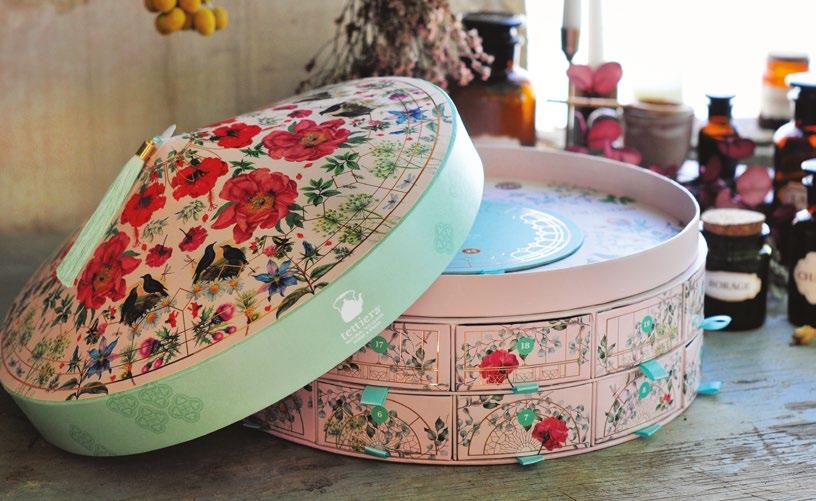
Editor: Sam Psaila
Art Direction: VOCĀB®
Contributors: Daleigan
Sabine Elridge
Elisa Eder
John Edwards
Eduardo Gandia Martinez
Miles Kaviraj
Jasper Linwood
Lena Marlowe
Eunice Muscat
Theo Nakamura
Petros Skarmoutsos
Amira Solano
Advertising: 7788 0300
Printing: Print It
Tettiera Presents: 25 Days of the Advent Conservatory
A Tea & Botanical Journey Step into a world where every morning begins with wonder. Discover 25 days of artisan teas, botanical infusions, and Mediterranean magic, each gift inspired by Malta’s wild beauty and the serene spirit of the Conservatory. Limited to just 100 pieces, pre-order now at www.tettiera.com EUR150





Chef Faisal left his comfortable life as a banker for a career as a chef consultant. His love for food was instilled by his mother, he has perfected his craft by studying cooking techniques in Europe. By establishing the Chef Faisal Consultancy, Faisal is able to not only share simple yet sophisticated dishes, but is also positioned to help restaurant businesses thrive.
Chef Lara Hansen is a home cook known for her refined yet heartfelt approach to cooking. Trained in Mediterranean cuisine, she blends classic techniques with bold, seasonal flavours inspired by her travels. Her dishes celebrate simplicity, colour, and balance, food that tells a story. For Served Magazine, Lara brings her creative flair to the table, transforming everyday ingredients into elegant, memorable experiences..
Inspired by her mother’s soulful home cooking and the vibrant energy of Chez Philippe, where he first fell in love with the rhythm of the kitchen, She brings heart and precision to everything he creates. His cooking style is seasonal, fresh, and local, rooted in Maltese tradition yet open to global influences. Whether crafting a comforting chicken broth or reinventing a classic rabbit stew, he believes food is about care, connection, and creativity.
A wine expert, who has called Malta home for the past seven years. Armed with a master's degree in marketing management, Petros has amassed extensive experience in the HORECA sector, excelling as an operations manager in both Greece and Malta. Known for his talent in curating impressive wine lists and cocktail menus, he has found his niche as the Wine Manager for Farsons Group since 2021.
"THE COOL BREEZE OF AUTUMN MEETS THE WARMTH OF CULINARY CREATIVITY. THIS EDITION CELEBRATES THE FLAVOURS OF THE SEASON, FEATURING TALENTED CHEFS WHO BRING COMFORT, COLOUR, AND PASSION TO THE PLATE WITH INSPIRING SEASONAL RECIPES."
HUNGER BY DESIGN
Exploring the intersection of food and creativity, how design shapes desire, emotion, and the very way we experience eating.

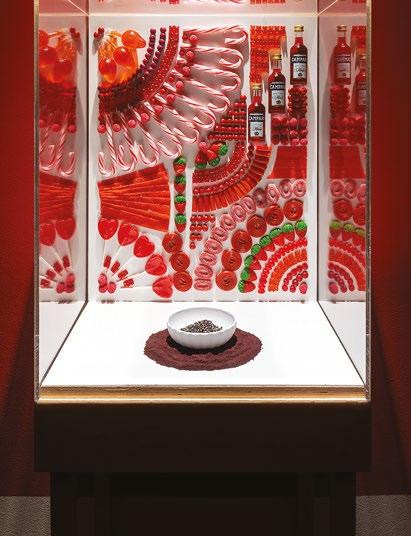
A TAKE ON PASTA SALAD
A vibrant beetroot spaghetti salad with grilled shrimp, chimichurri, and pomegranate.

SPEARS ALL SEASON
Celebrating asparagus in all its forms, tender, fragrant, and fleeting. A tribute to this green jewel and its endless versatility.


THE SHAPE OF TASTE
The right glass transforms wine beyond the bottle — revealing its true story, aroma, flavour, texture, and character.
THE LANGUAGE OF FLAVOUR
Chef Eunice Muscat shares her story, a celebration of rhythm, memory, and the soulful simplicity of seasonal, heartfelt cooking.
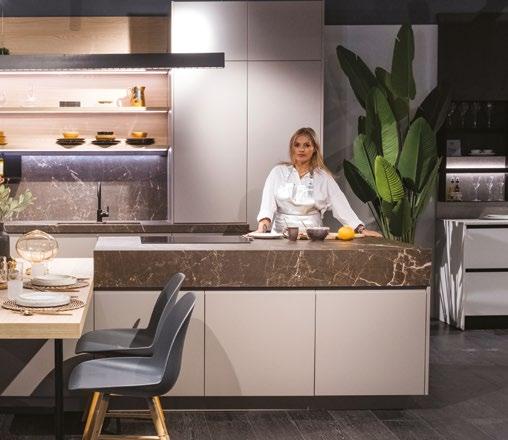
PIMP MY BRUNCH
A playful, sophisticated guide to pairing wine with brunch, from sparkling mornings to savoury classics, elevate every dish and moment.
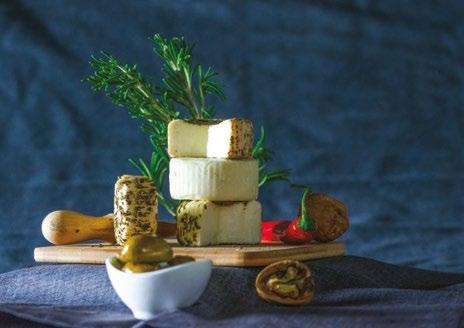
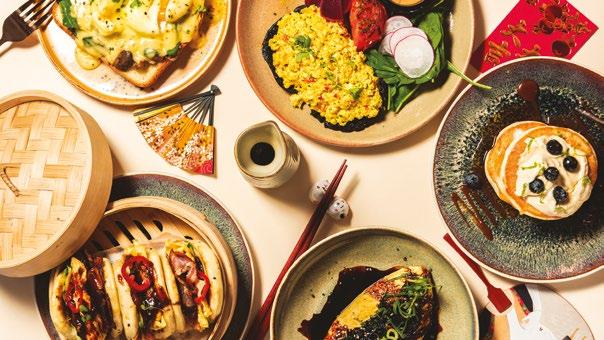
44 16 33
FOLK FOOD
A celebration of Malta’s beloved Gbejna, from ancient roots to modern craft, Benna preserves a timeless taste of tradition.
50
ORZO SEAFOOD & LOBSTER
Luxurious and deeply indulgent — orzo folded into creamy lobster bisque with tender prawns, mussels, and clams for pure seaside comfort.

HERE TO STAY
Kave Home’s Here to Stay celebrates timeless design, emotional connection, and enduring craftsmanship—creating pieces that become part of our lives.


54
STUFFED BEEF TENDERLOIN
Grilled stuffed beef tenderloin with beetroot sauce, spinach, and sundried tomato—served with seasonal vegetables, dill, and cranberries.
72
THE BULL PAVILION
At Zabb e Lee Cooking School, Chiangmai Life Architects’ bamboo Bull Pavilion blends food, culture, and sustainability—turning Thai cooking into artful meditation.

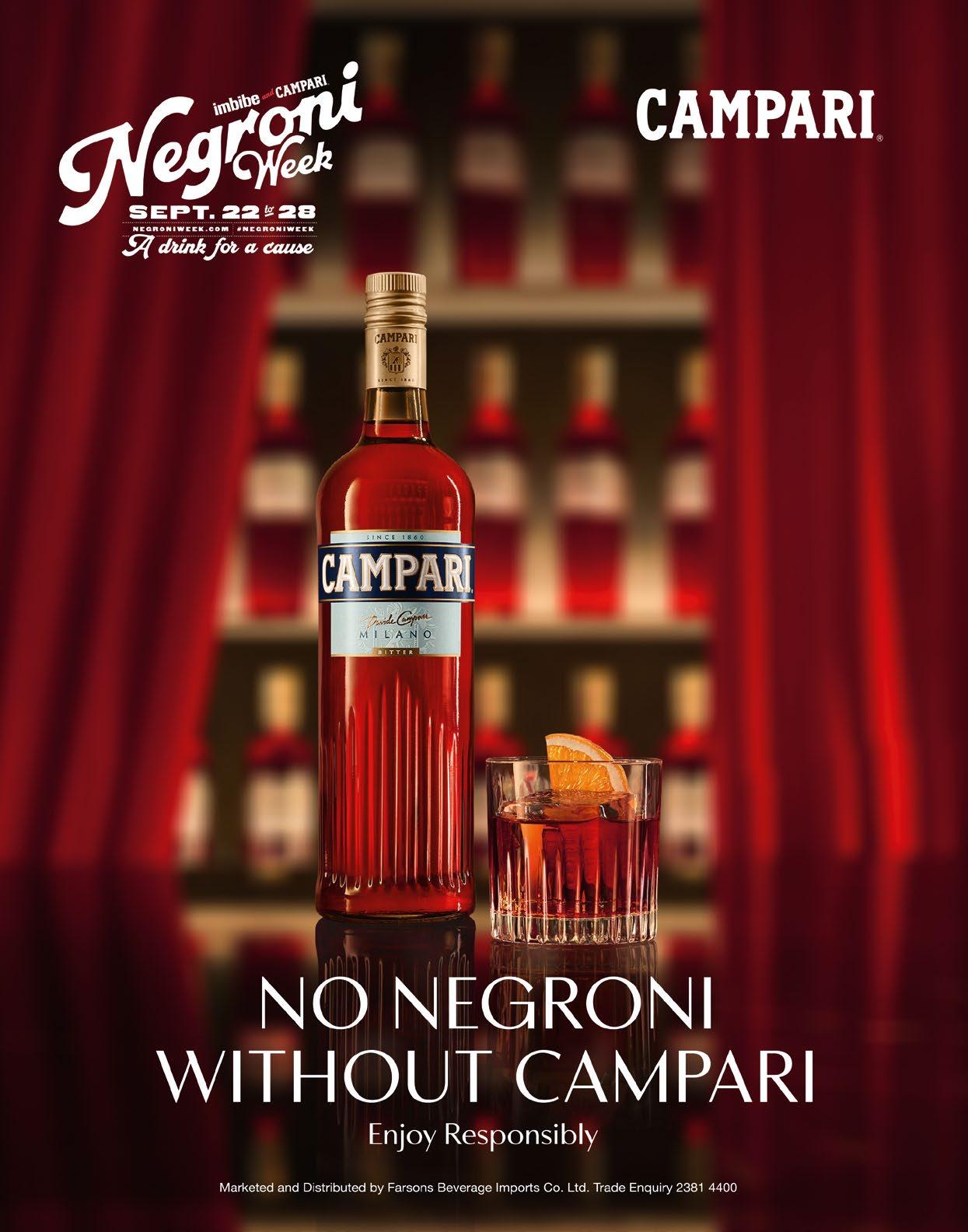

“AUTUMN INVITES US TO LINGER — OVER SIMMERING POTS, GOLDEN AFTERNOONS, AND THE QUIET JOY OF COMFORT FOUND IN FLAVOUR AND GOOD COMPANY.”
16. Pimp My Brunch
A playful, sophisticated guide to pairing wine with brunch, from sparkling mornings to savoury classics, elevate every dish and moment.
18. Spears All Season
Celebrating asparagus in all its forms, tender, fragrant, and fleeting. A tribute to spring’s green jewel and its endless versatility.
26. The Language of Flavour
Chef Eunice Muscat shares her story, a celebration of rhythm, memory, and the soulful simplicity of seasonal, heartfelt cooking.
33. Kave Home
Kave Home’s poetic campaign celebrates timeless design and the emotional bonds between people, places, and the objects that truly endure.
34. Hunger by Design
Exploring the intersection of food and creativity, how design shapes desire, emotion, and the very way we experience eating.
44. Ġbejna: Malta’s Tiny Treasure with a Rich Legacy
A celebration of Malta’s beloved cheeselet, from ancient roots to modern mastery, Benna preserves a timeless taste of tradition.

46. Simply Seafood
Salmon reimagined, smoky, citruskissed, and perfectly balanced with creamy tomato sauce, sautéed asparagus, black beans, and mint caviar elegance.
60. The Shape of Taste
Discover how the right glass transforms wine, revealing aroma, texture, and flavour in a sensory experience beyond the bottle.
64. Inspired by the season
Eunice Muscat creates a celebration of balance, vibrant seafood, crisp salads, and effortless dishes bursting with colour, texture, and coastal creativity.
72. Travel: The Bull Pavilion
A breathtaking bamboo structure where Thai culture, architecture, and cuisine unite, transforming cooking into an art of rhythm and reflection.
78. Stay Sweet
A vibrant fusion of mango, chia, and cream cheese, layered with cranberry caviar and maple coral chips for tropical elegance.

Scan the QR code to discover hundreds of mouthwatering recipes waiting for you!
Words Petros Skarmoutsos – Farsons

The Ultimate Guide to Wine for Every Brunch
Brunch is no longer just a lazy Sunday indulgence. It’s a ritual, a social event, and a chance to slow down with friends while enjoying good food and even better drinks. Plates overflow with sweet and savoury dishes, and the right glass of wine can turn a simple meal into something truly memorable. If you’ve already mastered eggs benedict, fluffy pancakes, and perfect avocado toast, it’s time to take things up a notch with wines that elevate brunch from casual to chic.
Sparkle Before Noon
No brunch feels complete without bubbles. While Prosecco and Cava keep things fun and easy, you can lift the experience with a refined Crémant or Champagne. Their bright acidity and freshness balance rich dishes like eggs
florentine or smoked salmon bagels, while their lively fizz adds a celebratory touch that suits a late-morning feast. For something playful, try a sparkling rosé. It pairs beautifully with fruit, pastries, and even fried chicken.
Whites That Brighten the Plate
Brunch sits between breakfast and lunch, which makes versatility key. A crisp Sauvignon Blanc complements eggs, herbs, and lighter plates. For something rounder, a lightly oaked Chardonnay adds depth to buttery quiches or croque monsieur. If you are leaning toward Mediterranean flavours such as tomatoes, olives, or feta, a Vermentino or Albariño makes a refreshing match.
Rosé All Day (Especially at Brunch)
Rosé is a natural fit for the brunch table. Its delicate fruit and gentle acidity pair perfectly with everything from fresh salads to charcuterie. Pale, Provence-style rosés feel effortlessly elegant, but deeper rosés can stand up to
savoury dishes like shakshuka or roasted vegetables. As a bonus, rosé looks gorgeous in the glass, making every table more inviting.
A Red for the Bold
Yes, red wine has a place at brunch. Keep it light and fresh. A chilled Pinot Noir pairs beautifully with mushroom omelettes, smoked meats, or a brunch burger. For a juicier option, try Beaujolais or Grenache, which bring bright fruit and soft tannins without overpowering the food.
If your brunch leans toward the sweet side with waffles, French toast, or fruit tarts, dessert wines are your best friend. Moscato d’Asti brings gentle fizz and floral sweetness, while a glass of Muscat de Beaumes-de-Venise or ice wine turns pastries into something unforgettable. Just remember, the wine should always be sweeter than the dish to keep the flavours in harmony.
Brunch, Elevated
Whether you’re toasting with Prosecco at Hammett’s or recreating the magic at home, the right wine turns brunch into an occasion. After all, the best pairings aren’t just about taste — they’re about fun, friendship, and that perfect touch of sparkle before noon. Inspired by Hammett’s Gastro Bar, our top brunch pairings celebrate an Asian twist on the classic — bold, creative, and effortlessly stylish.
Soufflé pancake, whipped cream, maple syrup, blueberry
Pair with: Moscato d’Asti
Delicate bubbles, floral aromas, and gentle sweetness turn these fluffy pancakes into a dream pairing. Moscato’s light fizz mirrors the pancake’s texture, while its fruitiness plays perfectly with blueberries and maple syrup. Try Fontanafredda Moscato d’Asti Le Fronde for a premium touch.

"BRUNCH IS NO LONGER JUST A LAZY SUNDAY INDULGENCE, IT’S A RITUAL."

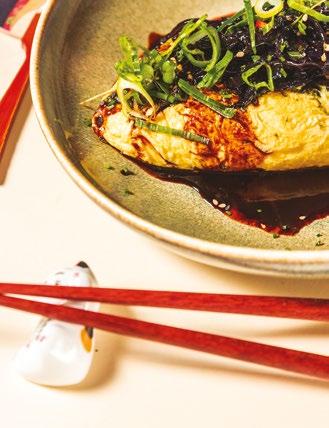
Korean Omelette (v)
Soft omelette, spring onion, kimchi, gochujang sauce, soy glaze
Pair with: Off-dry Riesling
Vibrant acidity and a touch of sweetness make Riesling the perfect partner for the punchy spice of gochujang and the tang of kimchi. Each sip refreshes the palate, letting the dish’s savoury complexity shine. Try Schloss Johannisberg Riesling Feinherb Gelblack for balance and lift.
Sliema | Saturday and Sunday, 11 am to 2 pm
Pair with: Sparkling Rosé
The salty-sweet crunch of bacon and the richness of egg meet their match in a chilled glass of sparkling rosé. The bubbles lift the umami of the hoisin, while the wine’s fruitiness complements the bao’s softness beautifully. Try Segura Viudas Cava Rosé for a great pairing.
At Hammett’s Gastro Bar, East meets West in a bold mix of flavour and creativity. From modern takes on brunch classics to fusion favourites like their famous Gua Bao buns, every dish is designed to surprise and delight. The Bottomless Brunch (€26 per person) includes two hours of free-flowing Serena Prosecco and a dish of your choice. Because nothing says weekend quite like a glass that never runs dry.
"AS THE DAYS GROW COOLER, HAMMETT’S GASTRO BAR BRINGS YOU DISHES THAT WARM THE SOUL AND SPARK INSPIRATION."

"Life’s better with a side of spears."
Words: Marcie Olson, Served Kitchen
sparagus is more than just a vegetable, it’s a ritual, a signpost of the season, and a fleeting delicacy that chefs and home cooks alike eagerly anticipate. Its arrival in markets signals the true beginning of the growing season, when tender green spears push through warming soil and fill baskets with promise. Though asparagus can now be found year-round thanks to imports, nothing rivals the snap, fragrance, and gentle sweetness of freshly harvested local asparagus in April. For a few brief weeks, it becomes the star ingredient, one worth celebrating at every table.
Asparagus has traveled a long path from ancient fields to the plates of modern gourmets. The Romans adored it, praising both its delicate taste and supposed medicinal powers. So revered was the vegetable that they devised special methods to transport it long distances, even freezing it in snow to preserve its prized freshness. Centuries later, asparagus experienced a renaissance of its own, gracing the lavish banquets of kings, queens, and aristocrats across Europe. In 17th-century France, it earned the nickname “the food of kings,” adored by Louis XIV, who ordered it cultivated in his royal gardens at Versailles.
That regal reputation never fully disappeared. Today, asparagus retains an aura of refinement, appearing on fine-dining menus in the spring as a mark of seasonality and elegance. Yet it has also become beloved in more casual kitchens, where its simplicity is its strength. Whether charred on a backyard grill or tucked into a farmer’s market frittata, asparagus has transcended its royal roots to become a democratic delight.
What makes asparagus so irresistible is its balance of subtlety and character. Its flavour sits somewhere between grassy freshness and nutty sweetness, while its texture offers the best of both worlds, crisp yet tender, juicy yet structured. Unlike many vegetables that require coaxing, asparagus needs very little to shine.
A drizzle of olive oil and a scatter of sea salt before roasting brings out caramelized depth. A quick steam and splash of lemon keeps it bright and lively. Shaved raw into ribbons, it becomes an unexpected salad, dressed simply with olive oil, parmesan, and a hint of pepper. Its natural versatility makes it a willing partner to almost any plate: luxurious alongside poached salmon, cozy with a golden-yolked fried egg, indulgent wrapped in prosciutto, or classic with hollandaise in the timeless dish asparagus à la Flamande.
Chefs love it for its adaptability, it can be pickled, puréed, grilled, or even tempurabattered, while home cooks appreciate its speed and ease. In under ten minutes, asparagus can be transformed into the centerpiece of a meal.
Asparagus isn’t just delicious — it’s a powerhouse of nutrition. Low in calories yet dense in vitamins, it’s rich in A, C, E, and K, plus folate, which plays a crucial role in cell growth and repair. Its high fiber content supports digestion and helps maintain steady energy levels, while its antioxidants, including glutathione, work quietly to protect the body from oxidative stress.
For centuries, asparagus has also been valued as a natural diuretic, helping the body shed excess water and salt, something the Romans noted long before modern nutrition confirmed it. With its blend of nourishment and lightness, asparagus feels almost tailor-made for spring,
when our palates crave foods that are as restorative as they are flavourful.
Perhaps what makes asparagus so beloved is its fleeting nature. Unlike vegetables that linger in the market for months, asparagus appears for only a short window in most regions. This brevity elevates it from everyday fare to a once-a-year celebration, much like strawberries in June or figs in late summer. Food lovers savor the ritual: the first bunch spotted at the farmers’ market, the rush to cook it while it’s at its sweetest, the inevitable farewell until next year.
In Malta, the picture is similar. Cultivated asparagus (Asparagus officinalis) is grown locally but follows a seasonal cycle, with its prime harvest falling between April and June. Beyond this window, spear production is limited, and most of what appears on supermarket shelves is imported. Malta also has its own wild relative, Asparagus aphyllus, which grows in rocky landscapes and can produce occasional shoots outside the main harvest period. These wild spears are often foraged, though they are smaller and less predictable than cultivated varieties. Together, they highlight asparagus’ dual personality: a treasured crop in the fields and a wild plant clinging to Mediterranean stone walls and countryside paths.
To make the most of asparagus, freshness is key. Look for spears that are firm and upright, with tightly closed tips and a vibrant color. Thicker stalks excel when grilled or roasted, developing smoky edges and a meaty bite, while thin spears are perfect for quick sautéing or tossing raw into salads. Always trim or snap off the woody ends before cooking, and if you’re blanching, remember to plunge the spears into ice water afterward to lock in that vivid green color.
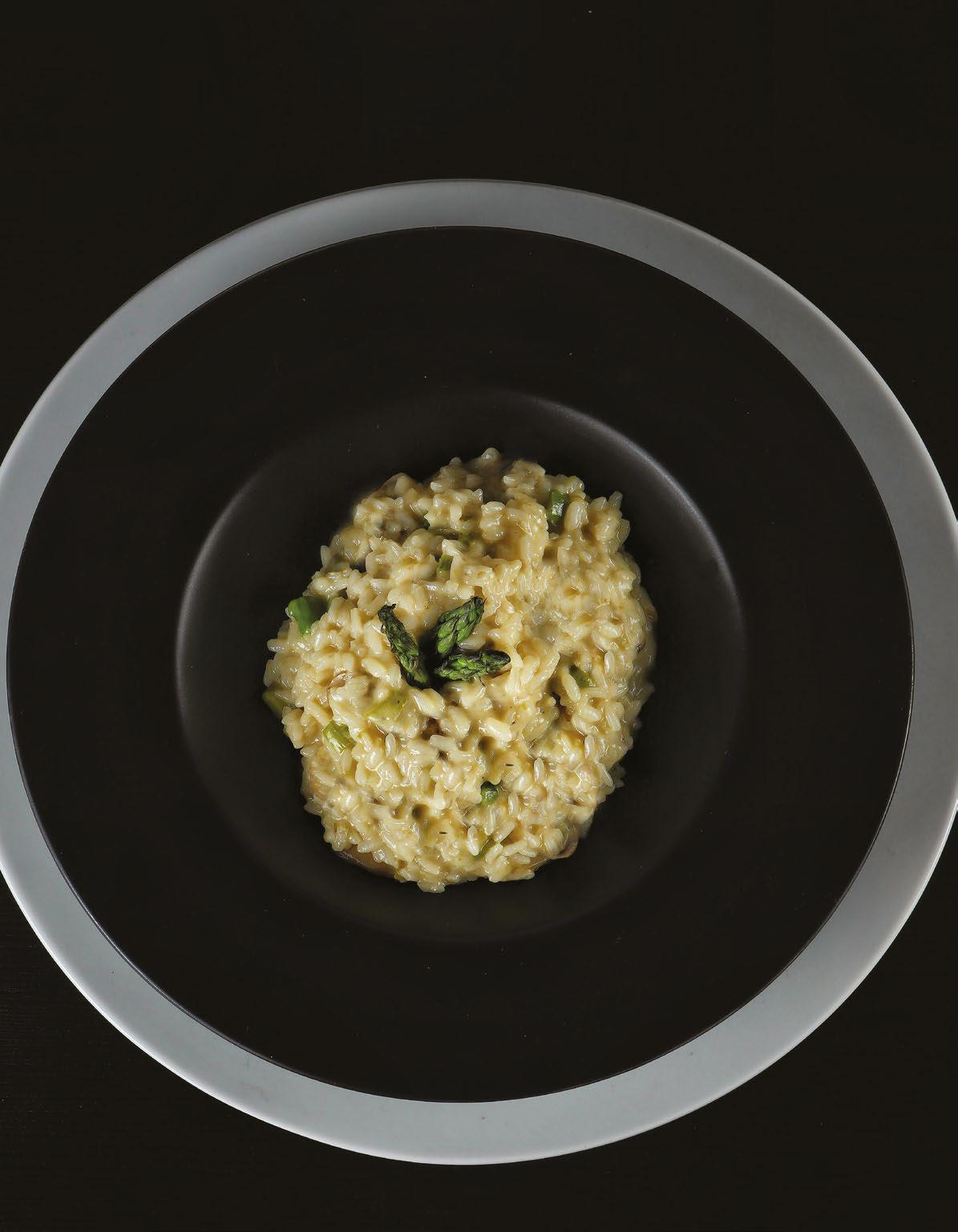
Prep/Cook time: 25min, Serves: 2
For the broth begin by roughly chopping onions, leeks, carrots, celery, and the woody ends of the asparagus stalks. Place everything in a large pot, cover with cold water, and add a bay leaf, a few parsley stems, and a pinch of salt. Bring it slowly to a simmer and let it cook gently for about an hour, skimming away
Ingredients:
200 g (1 cup) Carnaroli or Arborio rice
1 small onion or shallot, finely minced
300 g (10 oz) fresh asparagus
750 ml (3 cups) vegetable broth, kept warm
30 g (2 tbsp) butter, divided (half to cook, half to finish)
2 tbsp olive oil (optional, some use only butter)
60 ml (¼ cup) dry white wine
40 g (cup) Parmigiano Reggiano, freshly grated
Salt and freshly ground black pepper, to taste
Method:
Trim the woody ends from the asparagus and discard them. Cut off the tender tips and set them aside for later, then slice the remaining stems into small pieces about one to two centimetres long. To bring out the asparagus flavour, make a light asparagus broth: add the trimmings and sliced stems (except the tips) to the vegetable broth and let them simmer gently for fifteen to twenty minutes. Strain the broth and keep it warm over low heat.
any foam. If you want it autnentic, avoid strong flavours like garlic or rosemary, which could overpower the dish.
Once the broth has reduced slightly and developed a gentle sweetness, strain it through a fine sieve and keep it warm on the stove.
In a wide, heavy-bottomed pan, melt half of the butter together with the olive oil, if you are using it. Add the finely minced onion or shallot and let it cook very gently over medium-low heat until soft and translucent, taking care not to let it brown. Once the onion is tender, add the rice and stir constantly for a minute or two, toasting the grains until they are hot and slightly translucent at the edges. This step, known as tostatura, helps the rice cook evenly and develop a nutty aroma.
Pour in the white wine and stir until it has completely evaporated. Begin adding the hot asparagus broth one ladle at a time, stirring frequently. Each time the liquid is almost absorbed, add another ladleful. After about eight minutes of cooking, stir in the sliced asparagus stems.
Continue adding broth gradually, allowing the rice to absorb it slowly while releasing its starch to create a creamy texture. The process should take around eighteen minutes in total, until the rice is tender but still al dente.
Use this hot stock to cook the risotto gradually, adding a ladle at a time so the rice releases its starch and absorbs the fresh, green essence of the vegetables. A well-made stock gives asparagus risotto its signature creamy texture, subtle aroma, and clean, springlike taste, the hallmark of authentic Italian cooking.
A few minutes before the rice is done, add the asparagus tips so they stay bright and tender. When the risotto is ready, remove the pan from the heat and stir in the remaining butter and the grated Parmigiano Reggiano. Season to taste with salt and freshly ground black pepper, then cover the pan and let it rest for one or two minutes. This final step, called mantecatura, gives the risotto its rich, silky consistency.
Serve immediately on warm plates, letting the creamy rice spread slightly. If you like, finish with a drizzle of good olive oil or a few raw shaved asparagus tips for a fresh touch.

Prep/Cook time: 35min, Serves: 4

Ingredients:
500g fresh asparagus, trimmed and chopped (reserve a few tips for garnish)
1 tbsp olive oil or unsalted butter
1 small onion, finely chopped
1 garlic clove, minced
1 medium potato, peeled and diced (for extra creaminess)
750ml vegetable or chicken stock
100ml fresh cream (or substitute with Greek yogurt for a lighter version)
Salt and freshly ground black pepper, to taste
Optional garnish: a drizzle of cream, Parmesan shavings, olive oil, or microgreens
Method:
Prepare the asparagus
Trim off the woody ends and chop the spears into 3–4 cm pieces. Set aside the tips for later.
Sauté the aromatics
In a large pot, heat the olive oil or butter over medium heat. Add the onion and cook until soft and translucent, about 5 minutes. Add the garlic and cook for another 30 seconds until fragrant.
Add the vegetables
Stir in the chopped asparagus (except the tips) and the diced potato. Season lightly with salt and pepper, then pour in the stock. Bring to a boil, then reduce the heat and simmer for about 15 minutes, or until the asparagus and potato are tender.
Blanch the asparagus tips (for garnish)
While the soup simmers, blanch the reserved asparagus tips in boiling salted water for 2–3 minutes until bright green and tender. Drain and cool under cold water to keep their colour.
Blend the soup
Remove from the heat and blend using an immersion blender (or transfer to a stand blender) until smooth and creamy. Return to the pot.
Add the cream
Stir in the fresh cream and warm gently over low heat. Adjust seasoning with salt and pepper. If you prefer a thinner soup, add a splash more stock.
Serve
Ladle into warm bowls and top with the asparagus tips. Garnish with a drizzle of cream, a few Parmesan shavings, or a swirl of olive oil.
Chef’s Tip
For an elevated touch, finish with a squeeze of lemon juice or a hint of truffle oil just before serving, it enhances the freshness and adds a subtle layer of luxury.
The Regulator for Energy and Water Services (REWS), under the Ministry for the Environment, Energy and Public Cleanliness, is promoting sustainability through various support schemes that help households save energy and water, cut bills, and make greener choices.
The latest initiative, “Iftaħ u Ixrob” (Open the tap and drink), encourages people to enjoy tap water daily by improving its taste with activated carbon filters. There was once the perception that tap water wasn’t good because of its taste. Tap water was, and still is, safe, but now its taste is also being improved.
Following major upgrades by the Water Services Corporation, Malta and Gozo now enjoy the same great-tasting tap water everywhere. Chlorides and chlorine levels have been reduced by 30%, and over 70% of the supply now comes from reverse osmosis, guaranteeing top quality. Malta’s tap water also exceeds the strictest EU standards for safety and taste.
To make it even better, the Government, through REWS, is offering a 60% grant (up to €100) on activated carbon filters. Launched in March 2025, the Tap Water Scheme helps reduce single-use plastic bottles, lower costs, and make drinking water more convenient. By July 2025, REWS had already received 1,339 applications. People are switching to tap water because it’s mineral-rich, eco-friendly, affordable, and saves the hassle of carrying heavy bottles stored in the sun.
> Under-Sink Filters: Installed neatly under your kitchen sink, offering long-lasting filtration with minimal maintenance.

“TAP WATER IN MALTA NOW EXCEEDS THE STRICTEST EU STANDARDS FOR SAFETY & TASTE”
> Countertop Filters: Compact, portable, and easy to maintain — no installation required.
> Filter Jugs: The most affordable, portable option, with simple cartridge replacement.
> Faucet-Mounted Filters: Space-saving, directly attachable to your tap, with easy cartridge replacement.
From 1 July 2025, vulnerable households began receiving personalised vouchers of €100, redeemable for an activated carbon filter from participating retailers. These vouchers are valid until the end of 2025 and aim to support wider access to quality tap water. Vouchers were issued to over 13,000 beneficiaries, with more than 250 vouchers have been redeemed since July.
HOW TO APPLY:
1. Buy and install an activated carbon filter.
2. Apply to REWS within six months of purchase. For more details and to download the application form, visit www.rews.org.mt or apply online. You can also call 2295 5000 or email enquiry@rews.org.mt.
To view participating retailers for the voucher scheme, visit www.waw.org.mt.
At REWS, we believe in a greener Malta — one grant at a time.
Iftaħ u Ixrob – Open the tap and drink!


What’s your earliest food memory and is it something you still draw inspiration from today?
My earliest food memory is tied to two very special places: my mother’s kitchen and a restaurant called Chez Philippe. My mum’s cooking was simple but full of soul; every dish told a story. At Chez Philippe, where I later worked, I remember being captivated by the energy, the smells, and the precision in the kitchen. These early impressions still inspire everything I do today. They taught me that food isn’t just about taste—it’s about care, connection, and creativity.
When did you first realise you wanted to become a chef? Was there a moment that sealed it for you?
It started at Chez Philippe, where I was originally working front-of-house as a waiter. I was surrounded by a variety of cuisines and got to meet people from all walks of life. The energy of the kitchen drew me in. I found myself watching, learning, and slowly falling in love with the rhythm of it all. I realised I didn’t just want to serve food; I wanted to create it.
Do you have a go-to comfort dish that you love to cook when you're off the clock?
Chicken broth in the winter and grilled meat with salad in the summer. Simple, satisfying, and seasonal.
How would you describe your cooking style in three words?
Seasonal, fresh, local.
What’s the ingredient you can’t live without—and why?
Chilli—it adds just the right amount of heat and brings depth to so many dishes.
Is there a dish you’ve created that you’re especially proud of? Tell us the story behind it.
One that stands out is a traditional Maltese rabbit stew I cooked for my boss, Paul. It felt good to take something from my roots and make it my own.
Where do you usually find your inspiration—travel, people, books, ingredients?
All of those. Travelling, reading, and local markets especially—they always spark new ideas.
What’s your idea of the perfect dinner party? Who’s there, and what are you serving?
A casual mix of family and friends, with a spread of nibbles, vegetables, salads, and either fish or meat. Easygoing but full of flavour.
What’s the most unexpected lesson you’ve learned in the kitchen so far?
To switch off everything.
Quickfire: sweet or savoury? Bold or subtle? Plated or rustic?
Savoury, subtle, plated.


Prep/Cook time: 25min, Serves: 2
A FRESH AND ELEGANT DISH THAT’S PERFECT FOR A LIGHT LUNCH OR BRUNCH. CREAMY AVOCADO HALVES ARE FILLED WITH HERBED CREAM CHEESE AND TOPPED WITH DELICATE SLICES OF SALMON GRAVADLAX. FINISHED WITH ZESTY GARNISHES, THESE BOATS ARE SIMPLE, SATISFYING, AND FULL OF FLAVOUR.
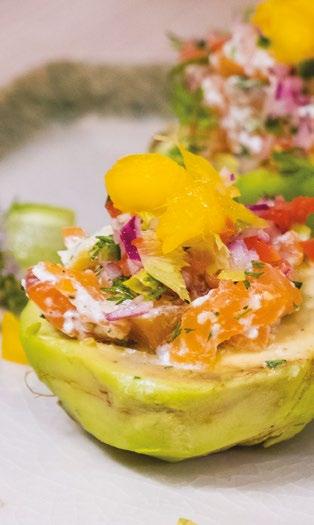
Avocado Boats with Salmon Gravadlax, Cream Cheese & Herbs
Ingredients
1 ripe but firm avocado, halved and pitted
80–100g (3–3.5 oz) salmon gravadlax, sliced
2–3 tbsp cream cheese (plain or herbed)
1 tsp lemon or lime juice
1 tbsp chopped fresh herbs (dill, chives, parsley or a mix)
Freshly ground black pepper
Optional garnish: capers, lemon zest, microgreens, or red onion slivers
Method
Cut the avocado in half and remove the pit. If the cavity seems small, use a spoon to gently scoop out a bit more flesh to create space for the filling. Drizzle each half with a little lemon or lime juice to keep the avocado from browning. In a small bowl, mix the cream cheese with the chopped herbs and a few grinds of black pepper. For added brightness, you can stir in a squeeze of lemon juice or a touch of horseradish if desired.
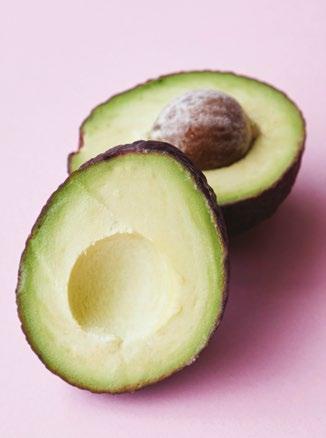
Recipe: Eunice Muscat
Spoon the herbed cream cheese into the center of each avocado half. Fold or roll the slices of salmon gravadlax and gently nestle them on top or partially into the cream cheese filling. Garnish with extra herbs, capers, lemon zest, red onion slivers, or microgreens for added flavor and visual appeal.
Serve immediately with crusty bread, rye toast, or cucumber ribbons for scooping.

There’s something quietly luxurious about dishes that don’t try too hard. This one is proof. Silky avocado, cool and green, meets folds of salmon gravadlax and a cloud of herbed cream cheese — the kind of combination that feels both effortless and refined.
It's a play of contrasts: creamy against cured, citrus against salt, richness lifted by herbs and a touch of zest. It’s a dish made for slow mornings or lingering lunches, the kind that asks for good bread, a chilled glass of something crisp, with nowhere in particular to be.




Also available with an automatic gearbox! starting from €17,900



KKave Home, the Girona-born design house with over 140 stores across five continents, has unveiled Here to Stay, a campaign that celebrates the timeless bond between people and the objects that make a house a home.
Marking the next chapter in Kave Home’s evolution, Here to Stay is more than a campaign; it is a manifesto. It reflects a vision that has guided the brand for over four decades: to create pieces built to last, both physically and emotionally. Following the brand’s rebranding in March 2025, this new creative direction deepens Kave Home’s commitment to thoughtful design and enduring quality.
Objects That Become Part of Our Lives
In a world defined by constant motion, Kave Home encourages us to slow down and reconnect with what truly matters. The home, they remind us, is not defined by walls or square footage; it is made up of stories, rituals, and the cherished objects that carry them forward. Each piece tells a tale, not only through its material
form but through the moments it witnesses and the memories it holds.
Kave Home’s design philosophy centres on longevity, both in construction and in character. Their collections embody a balance between contemporary design and timeless aesthetics, crafted from high-quality materials that stand the test of time. It is a deliberate shift away from disposable design and towards creating legacies that endure.
A Campaign that Moves Beyond the Frame
Filmed in the golden countryside of l’Ametlla del Vallès, near Barcelona, the Here to Stay campaign transforms this philosophy into poetic imagery. Directed by the &Rosàs agency, the film opens with a woman reading quietly in her living room. As she turns a page, the walls dissolve, the furniture rises, and the scene opens into a field of wheat bathed in Mediterranean light.
The visual metaphor is powerful: some objects drift away while others remain, symbols of the
enduring connections that make certain pieces part of who we are.
The campaign moves beyond traditional furniture advertising, instead offering a meditative reflection on belonging, identity, and permanence. It is a celebration of the slow beauty of life, and of the spaces that hold it.
Design with Purpose: Since its founding in 1984, Kave Home has been shaped by the essence of the Mediterranean — its warmth, simplicity, and deep connection to craft. From material selection to the partnerships it fosters, the brand remains grounded in its founding values: family roots, respect for people, and a love for honest design.
In Here to Stay, Kave Home affirms that good design is not about trends but about timelessness; about creating pieces that grow with us, that witness our lives, and that quietly, gracefully, become part of who we are.
Discover more at www.kavehome.com



AAt Served, we’re not just chasing flavour, we’re chasing the story behind it. Food doesn’t live only on the plate; it’s in the rituals, the branding, the hype, the way desire is designed long before the first bite. Which is exactly why we found ourselves at Design Museum Holon, where the exhibition FOOD is busy turning the edible world into an Instagrammable, multisensory playground.
This isn’t a polite stroll past a few pretty objects. FOOD is an all-out banquet for the senses: over 200 works, from global design heavyweights to provocative newcomers, all wrestling with the same question, how does design shape our hunger? The answers are as playful as they are unsettling. Expect knitted steaks, fast-food wrappers transformed into sacred geometry, colour-bending illusions, and even a machine that simulates the human digestive tract in all its uncomfortable glory.
For us at Served, it’s the perfect kind of field trip, bold, clever, a little irreverent, and guaranteed to leave you hungry, but not necessarily for dinner. >>

Food doesn’t just feed us, it seduces, performs, and occasionally misbehaves. Before flavour ever makes contact with the tongue, appetite is already in full swing. The hiss of oil as an egg hits the pan, the earthy perfume of sourdough cracking open, the glossy tease of a peach on the brink of collapse, these are the opening acts in the theatre of hunger. Eating, after all, is never just biological. It’s culture, it’s politics, it’s branding, it’s theatre. Enter FOOD, Design Museum Holon’s latest blockbuster exhibition (open until 11 November 2023), where dining is dissected, redesigned, and, yes, Instagramready.
FOOD isn’t a show, it’s a feast. Across the museum’s sweeping, sculptural spaces, more than 200 works by designers and artists are plated up, from witty object design to immersive, full-on installations. Expect sharp contrasts: playful gestures next to visceral provocations; conceptual cool beside the gloriously grotesque. Together, they serve one burning question: how does design shape the way we crave, consume, and remember food?
Some highlights are cheeky, others downright shocking. A knitted steak, soft and ironic, flips carnivorous indulgence into cosy domestic craft.

Wim Delvoye’s notorious Cloaca machine, essentially a mechanical digestive tract, growls away with clinical precision, producing excrement as its grand finale (not for the squeamish). A Junk Food Mandala transforms discarded wrappers into kaleidoscopic icons, reframing consumer waste as something almost holy. Elsewhere, international stars, Naoto Fukasawa, Ron Arad, Studio Lernert & Sander, push food into the realm of commentary and spectacle. This isn’t dinner; it’s design with a side of provocation. >>


..."Some highlights are cheeky, others downright dramatic. A knitted steak, soft and ironic, flips carnivorous indulgence into cosy domestic craft"...


"At Design Museum Holon, food is reframed not as

sustenance, but as mirror, stage, & battleground."


"A GLIMPSE INTO TOMORROW’S APPETITES — WHERE DESIGN, DESIRE, AND DISGUST CONVERGE. IT’S PART ART, PART SPECULATION, PART FEVER DREAM."

Chief Curator Maya Dvash frames it as the next logical step in Holon’s sensory journey. “We’ve explored vision, we’ve explored sound. Taste was inevitable. Food is the ultimate curated experience, every idea reflects choices that reveal who we are, how we live, and what we value.”
The exhibition unfolds like a tasting menu with three courses. The main show, curated by Liora Rosin and Dana Benshalom, dives into food as seduction, the shimmer of glaze, the fizz of carbonation, the crunch that exists as much in our imagination as our mouths.
The Peripheral Corridor Gallery serves Colored, curated by *Lior Hermoni Gati. It’s a feast for the eyes that proves colour isn’t garnish, it’s power. Pink reads as indulgent, green signals wellness, black is transgressive. Every hue whispers to our subconscious before we’ve even taken a bite.
And then comes dessert: A Taste of the Future in the Design Laboratory, curated by Talia Yanover. It’s part art, part speculation, part fever dream. With AI, scent, and interactive design, it asks what tomorrow’s horror foods might look like: lab-grown luxury cuts, zero-waste snacks, algae chic, climate-conscious menus engineered for TikTok virality. You’ll leave wondering whether

your poor grandchildren will be left craving burgers… or bio-pods.
But FOOD isn’t just spectacle. It reminds us that what we eat is never neutral. Every snack is a story, every recipe an archive, every craving a clue to our collective psyche. Food is how we bond, how we flex our values, how we broadcast our identities. It’s heritage, rebellion, comfort, and performance, all in one mouthful.
At Design Museum Holon, food is reframed not just as sustenance but as mirror, stage, and battleground. And like the most memorable meals, the exhibition lingers long after you’ve left, leaving you full, but also hungry for more.>>
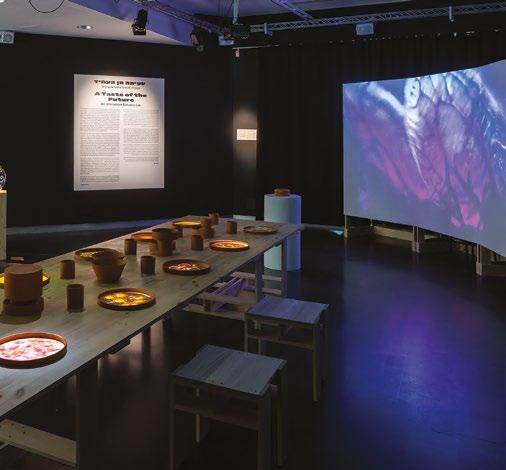

In the world of artisanal cheese, few can claim a legacy as rich or as small as Malta’s beloved ġbejna. More than just a cheeselet, ġbejna is a symbol of Malta’s agricultural roots, linguistic evolution, and culinary resilience. Its story begins centuries ago, but today, it continues to define local dishes and delight modern palates thanks to dedicated producers like Benna, who have preserved and elevated this tradition with an extensive range of expertly crafted ġbejniet.
The earliest known reference to ġbejna dates back to 1796, when Maltese linguist Mikiel Anton Vassalli recorded it as a diminutive of
ġobna, meaning cheese. Interestingly, this term is not exclusive to Maltese. In modern Arabic, ġbejna, still translates to “small cheese”, revealing a linguistic connection that stretches back to Siculo-Arabic influences introduced during the High Middle Ages.
Historically, the word ġbejna stood alone to signify a small cheese, with further descriptors, such as tan-nagħaġ (sheep’s), tal-mogħoż (goat’s), or tal-bżar (peppered), added to indicate its type or flavour. The renowned Gozitan ethnographer Agius de Soldanis, writing in the 18th century, referenced many cheese types under the umbrella term
ġobon, describing the now-familiar small forms as “piccolissime forme del cacio fresco dissecato”, tiny rounds of dried fresh curd, preserved in clay jars.
Ancient Cheese with a Modern Twist Cheese-making on the Maltese Islands predates written history. Archaeologists discovered ceramic cheese baskets in Baħrija dating back over 3,000 years, still containing traces of cow’s milk protein. Throughout the medieval period, notarial records documented the value placed on livestock cows, sheep, goats and their milk, all of which contributed to a zero-waste dairy culture.
Folk legends even tell of a siege in 1427, when human milk was mixed with animal milk to produce ġbejniet and mislead invading forces. By the 20th century, folklorists Anton F. Attard and Guido Lanfranco were documenting regional variations, from the snowy white goat’s milk cheeses of Malta to the golden, sheep’s milk ġbejniet of Gozo, highlighting differences in size, texture, and production methods passed down through generations.
Benna: Championing a National Icon While ġbejna’s heritage is deep-rooted, its future is proudly modern, thanks in large part to Benna, Malta’s national dairy brand. In 1958, Malta’s dairy farmers formed a cooperative that later acquired the island’s main dairy processing facilities. By 1990, Benna introduced a pasteurised, vacuum-sealed ġbejna made from cow’s milk, a product that immediately struck a chord with consumers seeking traditional flavour with guaranteed safety and quality.
Today, Benna offers a collection of seven expertly crafted ġbejniet, each one a reflection of Malta’s flavour palette and Benna’s

dedication to artisanal quality with modern hygiene standards.
Explore Benna’s Range of Ġbejniet
Each Benna ġbejna is made using fresh, pasteurised cow’s milk and a blend of tradition and innovation. Whether you’re cooking, snacking, or plating for guests, there’s a Benna ġbejna for every occasion:
•Ġbejna Friska – Soft, fresh, and mild, this classic cheeselet is perfect for cooking, eating on its own, or blending into traditional dishes like Soppa tal-Armla. Its light texture and clean taste make it a Maltese staple.
•Ġbejna Bajda – A semi-hard white cheeselet that strikes the perfect balance between firm and creamy. Mildly salted, it’s ideal on platters or gently fried for a comforting crunch.
•Ġbejna Moxxa – Soft and spreadable, this variant is delightfully creamy, making it a star ingredient in both savoury and sweet recipes. Excellent as a filling or a flavourful base.
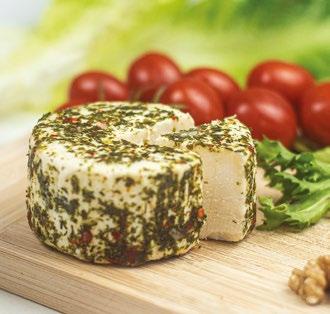
•Ġbejna Tal-Bżar – Rolled in crushed black pepper, this semi-hard cheeselet delivers bold, spicy notes with every bite. It adds character to any dish or platter.
•Ġbejna Mħawra – Infused with chives, onions, and chilli, this zesty cheeselet brings a modern, spicy edge to traditional cheesemaking. Fantastic with crackers or in wraps.
•Ġbejna Sagħtar u Kosbor – Herbal and aromatic, this version includes thyme and coriander, capturing the flavours of the Mediterranean in every bite.
•Ġbejna Tal-Ħabaq – A delicious twist seasoned with basil and garlic, perfect for summer salads, focaccias, or grilled vegetable dishes.
From the fresh and delicate to the herbaceous and bold, Benna’s range of ġbejniet showcases the full potential of this iconic Maltese cheese, bringing traditional tastes to modern tables with care, flavour, and finesse.
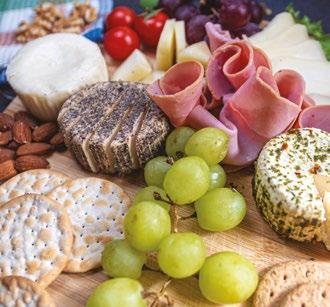
IT’S SALMON, REIMAGINED. THE FILLET RESTS ON VELVETY TOMATO SAUCE, LIFTED BY SAUTÉED ASPARAGUS, BLACK BEANS, AND A POP OF MINT CAVIAR. SMOKY, CITRUS-KISSED, AND PERFECTLY BALANCED, PROOF THAT COMFORT AND COUTURE CAN SHARE A PLATE.
Ingredients:
For the Creamy Tomato Sauce
100g peeled tomatos
30g carrot
5g garlic
10g sliced red onion
½ tsp sea salt
1 pinch black pepper powder
10g butter
1 tsp white sugar
10ml olive oil
5g celery sticks
1 pinch dry basil leaves
1 pinch dry thyme
For the Sautéed Vegetables
4 pcs asparagus
15g black beans
1 pinch sea salt
1 pinch black pepper powder
1 pinch Italian seasoning
5g butter
For the Salmon Marinade
150g salmon
2 pinches sea salt
1 pinch black pepper powder
5ml lemon juice
5ml olive oil
For the Mint Caviar
100ml mint juice
½ tsp agar-agar powder
1g salt
1 pinch black pepper powder
10 g white sugar
For Assembly
60g creamy tomato sauce
150g grilled salmon
4 pcs sautéed asparagus
15g sautéed black beans
1 tsp mint caviar
1 fried basil leaf
2 slices spring onion
Method:
Creamy Tomato Sauce
In a cooking pot, combine all ingredients and cook on low heat for 30 minutes. Remove from heat and blend for 2 minutes until smooth.
Sautéed Vegetables
Blanch the asparagus. In a frying pan, add butter and sauté the asparagus and black beans with seasoning for 2 minutes.
Salmon Marinade
In a mixing bowl, combine all ingredients and marinate the salmon for 20 minutes. Grill on all sides for about 5 minutes.
Mint Caviar
In a saucepan, heat all ingredients except agar-agar and boil for 5 minutes. Add agar-agar, boil for another 2 minutes, strain, and transfer to a squeeze bottle. Cool to at least 30°C.
Drop into 500 ml chilled corn oil drop by drop to form caviar. Strain the oil and rinse the caviar in cold water.
Assembly
Spread the creamy tomato sauce on a plate and place the grilled salmon on top. Arrange the sautéed vegetables beside the salmon and garnish with mint caviar, fried basil, and spring onion.
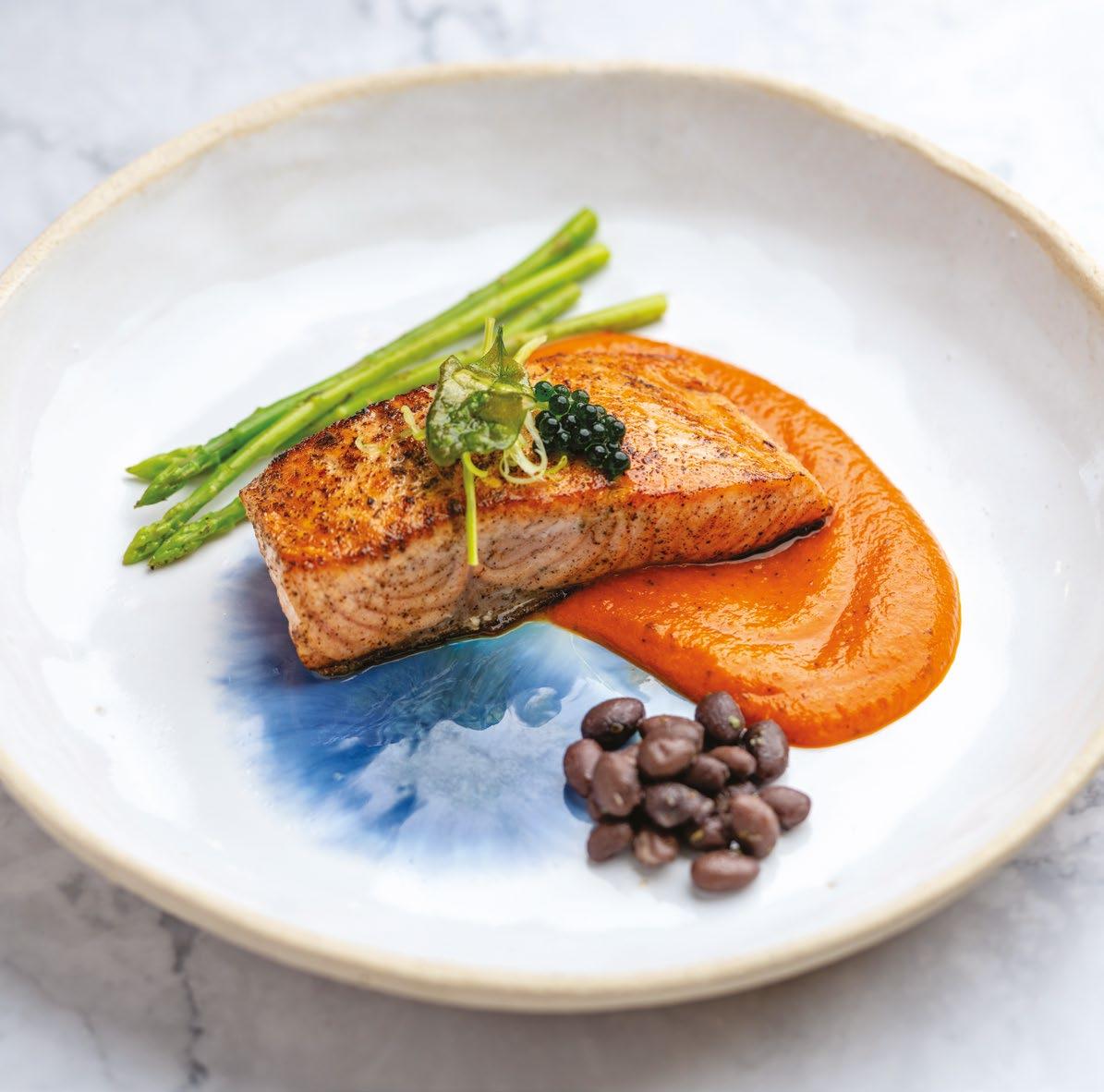
Cook Time: 20mins – Serves 1

Ingredients:
For the Chimichurri Sauce
5g chopped parsley
5g chopped cilantro
5g chopped garlic
¼ tsp dry oregano
3g chili flakes
40ml olive oil
8ml red wine vinegar
2ml lemon juice
5g chopped red onion
2g chopped mint
½ tsp sea salt
¼ tsp black pepper powder
1 tsp sugar
For the Spaghetti Pasta
200g boiled pasta
50ml beetroot juice
1 liter water
1 tsp salt
30ml olive oil
For the Grilled Shrimps
60g shrimps ¼ tsp salt
1 pinch black pepper powder
2ml lemon juice
10ml olive oil
¼ tsp smoked paprika
1 pinch thyme powder
For the Sautéed Cherry Tomatoes
3 red cherry tomatoes
1 pinch salt
1 tsp olive oil
1 pinch Italian seasoning
1 pinch black pepper powder
For the Pomegranate Reduction
20ml pomegranate molasses
5ml red wine vinegar
1 pinch black pepper
1 pinch salt
½ tsp brown sugar
1 pinch thyme powder
For Assembly
80g spaghetti pasta
30ml chimichurri sauce
20g edamame
10g green sprouts
5g pomegranate seeds
1 pinch dill leaves
1 tsp parmesan cheese
50g grilled shrimps
20g sautéed cherry
tomatoes
10ml pomegranate reduction
Method:
Chimichurri Sauce
Combine all ingredients in a mixing bowl and stir until well mixed.
Spaghetti Pasta
In a saucepan, combine water, beetroot juice, salt, and olive oil. Bring to a boil, add the pasta, and cook for 9–10 minutes. Strain, rinse under cold water, and toss with the some olive oil.
Grilled Shrimps
Mix all ingredients in a bowl to coat the shrimps well. Grill until cooked through.
Sautéed Cherry Tomatoes
Combine ingredients in a bowl, then sauté in a pan until lightly cooked.
Pomegranate Reduction
Combine all ingredients in a saucepan and cook over medium heat for 10 minutes.
Assembly
Place the pasta on a plate. Arrange the shrimps, sautéed cherry tomatoes, sprouts, edamame, pomegranate seeds, and dill leaves around the pasta. Top with chimichurri sauce and finish with parmesan cheese and a side of pomegranate reduction.

Ingredients:
By Chef Faisal –
For the Roasted Garlic Sauce
20g roasted garlic purée
15ml tomato paste
1 pinch dry basil powder
2 pinches sea salt
1 pinch black pepper powder
20g butter
40ml cooking cream
15g parmesan cheese
For the Roasted Garlic Purée
40g garlic
1 pinch sea salt
1 pinch black pepper powder
5ml olive oil
20ml water
For the Shrimp Marinade
60g shrimps
¼ tsp salt
1 pinch black pepper powder
2ml lemon juice
10ml olive oil
¼ tsp smoked paprika powder
1 pinch thyme powder
For the Sautéed Cherry
Tomatoes
3 red cherry tomatoes
¼ tsp salt
1 tsp olive oil
1 pinch Italian seasoning
1 pinch black pepper powder
For Assembly
150g boiled fettuccini pasta
80g roasted garlic sauce
4 pcs grilled shrimp
2 pcs sautéed cherry tomatoes
1 pinch chopped parsley
2 pinches parmesan cheese
Method:
Roasted Garlic Sauce
In a saucepan, melt the butter and sauté the tomato paste for 2 minutes. Add the remaining ingredients and cook over low heat for 15 minutes.
Roasted Garlic Purée
In a bowl, toss the garlic with sea salt, black pepper, and olive oil. Roast in a preheated oven at 220°C for 10 minutes. Transfer the roasted garlic and water to a blender and blend for 2 minutes until smooth.
Shrimp Marinade
Combine all ingredients in a bowl and mix well. Marinate the shrimp for 20 minutes, then grill on a preheated griller for 3 minutes on each side.
Sautéed Cherry Tomatoes
In a pan, heat the olive oil, add the tomatoes, and sauté with the seasonings until lightly cooked.
Assembly
In a pan, toss the pasta with the roasted garlic sauce until well coated. Arrange the pasta on a plate and top with grilled shrimp. Garnish with sautéed cherry tomatoes, chopped parsley, and a sprinkle of parmesan cheese.
By Kora, St Pauls Bay – Prep /Cook
Seafood has a way of turning a weekday dinner into a celebration, and this recipe does just that: a bowl of orzo luxuriating in lobster bisque, cream, and white wine, studded with the jewels of the sea. Think Rossi prawns, mussels, clams, calamari, and octopus, each cooked just long enough to whisper of the ocean without losing its tenderness.
The dish begins with orzo, that small, riceshaped pasta that soaks up flavour like a sponge. Cook it al dente and let it wait patiently, the real action happens in the skillet.
Ingredients:
220g lobster bisque
4 Rossi prawns
152g mussels in shell
152g vongole (clams) in shell
116g baby calamari, cleaned
92g octopus
40g unsalted butter
76g cream
4g fresh parsley, finely chopped
4g sea salt
Pinch freshly ground black pepper
8g shallot, finely diced
40g white wine
8g lemon juice
116g orzo pasta
4g minced garlic
Butter, shallots, and garlic form the aromatic base, lifted with a splash of white wine that reduces to a fragrant, glossy foundation.
The seafood enters in stages, each piece treated with the respect it deserves. Shells open, flesh firms, and then the shellfish are whisked away to avoid the cardinal sin: overcooking. What remains in the pan is pure indulgence. Lobster bisque, cream, and lemon juice combined into a sauce that’s equal parts silk and decadence. Salt and pepper sharpen the edges, parsley freshens the mood.
Method:
Cook the orzo
Bring a pot of salted water to a boil. Cook the orzo until al dente, then drain and set aside.
Sauté the aromatics
In a wide skillet, melt the butter over medium heat. Add the shallot and garlic, cooking until fragrant and translucent. Deglaze with white wine and allow it to reduce slightly.
Cook the seafood
Gently add the prawns, mussels, clams, calamari, and octopus. Cook until the shells open, then remove the shellfish to a bowl to avoid overcooking.
When the orzo is folded back in, every grain becomes a vessel of flavour, clinging to that bisque-rich cream. The seafood returns at the last moment, just warmed through, bringing its briny sweetness back to the mix.
Plated in warm bowls, the dish is garnished with parsley and perhaps a drizzle of extra virgin olive oil for that final glossy magazine finish. It’s indulgent yet elegant, a recipe that feels as comfortable in a seaside trattoria as it does at your own kitchen table.
Prepare the sauce
Stir in the lobster bisque, cream, and lemon juice. Simmer for 2–3 minutes until slightly thickened, seasoning with salt and pepper to taste.
Combine pasta and seafood
Fold in the cooked orzo, ensuring each grain is luxuriously coated in sauce. Return the seafood to the pan and warm gently.
Plate with elegance
Divide the pasta between two warm bowls. Scatter with fresh parsley and, if desired, drizzle lightly with extra virgin olive oil for a final glossy touch.



Ingredients:
For the Beetroot Sauce
40g roasted beetroot
30ml blueberry purée
5ml pomegranate molasses
1 pinch sea salt
1 pinch black pepper powder
5g butter
20ml water
For the Roasted Beetroot
60g beetroot
1 pinch sea salt
1 pinch black pepper powder
10ml olive oil
For the Stuffed Tenderloin
150g beef tenderloin
40g spinach
20g sundried tomato
1 pinch sea salt
1 pinch black pepper powder
For the Grilled Vegetables
5 pcs asparagus
2 pcs French beans
1 pinch sea salt
1 pinch black pepper powder
1 pinch Italian seasoning
5ml olive oil
For Assembly
4 pcs grilled stuffed tenderloin
7 pcs grilled vegetables
60g beetroot sauce
1 pinch chopped dill leaves
1 pinch dried cranberries
Method:
Beetroot Sauce
Blend all ingredients in a sauce blender for 3 minutes. Transfer to a saucepan and cook over medium heat for 5 minutes.
Roasted Beetroot
Cut the beetroot into 1-inch cubes. Toss with salt, pepper, and olive oil. Spread on a tray and roast in a preheated oven at 220°C for 20 minutes.
Stuffed Tenderloin
Slice the tenderloin lengthwise into 4 strips. In a bowl, mix the spinach, sundried tomato, salt, and pepper. Divide into 4 portions, stuff each beef strip, and roll tightly. Grill the tenderloin on all sides until browned.
Grilled Vegetables
Blanch the vegetables. In a frying pan, toast them with olive oil and seasoning.
Assembly
Spread the beetroot sauce on a plate and arrange the grilled tenderloin on top. Place the grilled vegetables beside it and garnish with dill leaves and dried cranberries.
"THIS ELEGANT DISH BRINGS TOGETHER THE RICHNESS OF BEEF TENDERLOIN WITH THE EARTHINESS OF ROASTED BEETROOT AND THE SUBTLE SWEETNESS OF BLUEBERRIES AND POMEGRANATE. FRESH GREENS, SUN-DRIED TOMATOES, AND DELICATELY GRILLED VEGETABLES
BALANCE
VIBRANCY, CREATING A PLATE THAT’S AS BEAUTIFUL TO SERVE AS IT IS REWARDING TO EAT."

By Chef Faisal

Ingredients:
For the Avocado Spread
60g avocado
15ml Greek yogurt
2ml Dijon mustard
1 pinch sea salt
1 pinch white pepper powder
2ml lime juice
1g cilantro
For the Sesame Herb Mix
10g mixed sesame seeds, toasted and crushed
40ml olive oil
3g chili flakes
1tsp smoked paprika powder
¼ tsp sea salt
1/8 tsp black pepper
10g chopped parsley
For the Roasted Corn Ribs
1 sweet corn
5ml olive oil
¼ tsp sea salt
1/8 tsp black pepper powder
¼ tsp dry oregano
For Assembly
8 pcs roasted corn ribs
60ml avocado spread
30g sesame herb mix
1 pinch sumac powder
1 pinch chopped dill leaves
Method:
Avocado Spread
Place all ingredients in a blender and blend for 1 minute until smooth.
Sesame Herb Mix
Combine all ingredients in a mixing bowl and stir well to combine.
Roasted Corn Ribs
Cut the corn into 8 ribs. Toss with olive oil, salt, pepper, and oregano. Roast in a preheated oven at 200°C for 10 minutes.
Assembly
Spread the avocado on a plate. Arrange the roasted corn ribs on top, drizzle with the sesame herb mix, and garnish with sumac powder and chopped dill.
Prep Time: 10mins – Cook Time: 15mins – Serves 1

Ingredients:
For the Avocado Tartar
40g avocado, diced
2g cilantro, chopped
5g red onion, chopped
10g pineapple, chopped
¼ tsp sea salt
1/8 tsp black pepper powder
2g jalapeño pickle, chopped
5ml olive oil
3ml lemon juice
10ml mayonnaise
For the Garlic Sauce
30ml mayonnaise
¼ tsp garlic powder
1 pinch parsley
5ml olive oil
For the Tomato Caviar
100ml tomato juice
½ tsp agar-agar powder
¼ tsp salt
1 pinch basil powder
1 pinch black pepper powder
1/8 tsp thyme
For Assembly
2 pcs fried crispy spring roll sheets
60ml avocado tartar
20ml garlic sauce
2 tsp tomato caviar
1 boiled egg
1 pinch sumac powder
thoroughly.
Garlic Sauce
Add all ingredients to a bowl and mix well until smooth.
Tomato Caviar
In a saucepan, combine all ingredients except the agar-agar. Bring to a boil and cook for 5 minutes. Add the agar-agar and boil for another 2 minutes. Strain the mixture, transfer to a squeeze bottle, and allow to cool to about 30°C.
Prepare chilled corn oil (500 ml) and gently drop the tomato mixture into the oil drop by drop to form caviar. Strain the oil and rinse the caviar in cold water.
Assembly
Cut the spring roll sheets into quarters and fry until golden and crisp. On a serving plate, layer the crispy sheets and fill with avocado tartar. Top with half a boiled egg, drizzle with garlic sauce, and finish with tomato caviar and a sprinkle of sumac powder.
Quinoa & Couscous Medley
Prep Time: 20mins – Cook Time: 5mins – Serves 1
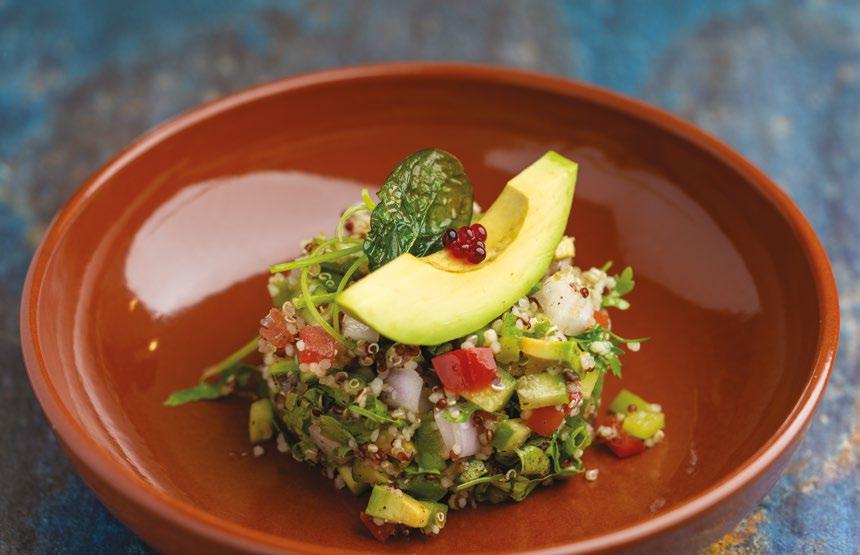
Ingredients:
For the Italian Dressing
40ml olive oil
15ml lemon juice
1 pinch dry basil powder
2 pinches sea salt
1 pinch black pepper powder
¼ tsp garlic powder
10ml honey
10ml red wine vinegar
1 pinch oregano
For the Cranberry Caviar
100ml cranberry juice
½ tsp agar-agar powder
1/8 tsp salt
1 pinch dry mint powder
5g sugar
For Assembly
1 avocado slice
30g chopped avocado
5g chopped parsley
10g chopped tomato
10g mixed bell peppers, chopped
15g chopped cucumber
10g chopped red onion
30g boiled mixed quinoa
20g boiled couscous
40ml Italian dressing
¼ tsp cranberry caviar
1 fried basil leaf
4 slices spring onion, julienned
Method:
Italian Dressing
Combine all ingredients in a blender and blend for 1 minute, adding the olive oil gradually.
Cranberry Caviar
In a saucepan, heat all ingredients except the agaragar and boil for 5 minutes. Add agar-agar, boil for another 2 minutes, strain, and pour into a squeeze bottle. Cool to at least 30°C.
Drop into 500 ml chilled corn oil drop by drop to form caviar. Strain the oil and rinse the caviar in cold water.
Assembly
In a mixing bowl, toss all chopped ingredients with the Italian dressing. Place the salad on a plate and top with the avocado slice, fried basil, and cranberry caviar.
By Chef Faisal –
Prep Time: 30mins – Cook Time: 5mins – Serves 1

Ingredients:
For the Chicken & Corn Marinade
1 pinch sea salt
1 pinch black pepper powder
1 pinch chicken stock powder
1/8 tsp garlic powder
¼ tsp sweet paprika powder
20g corn flour
50g chicken breast
50g sweet corn
10ml pomegranate reduction
For the Chicken Mix
80g fried chicken and corn
3g chopped garlic
20g spring onion
30g bell pepper
0.5g black pepper
0.5g chicken stock powder
0.2g Italian seasoning
10g olive oil
For the Pomegranate Reduction
20ml pomegranate molasses
5ml red wine vinegar
1 pinch black pepper powder
1 pinch salt
2g brown sugar
1 pinch thyme powder
For the Dill Mayo Sauce
30g mayonnaise
1 pinch dry dill leaves
1 pinch sea salt
1 pinch black pepper powder
2g honey
For Assembly
3 pcs fried spring roll sheets
90g chicken mix
3 pcs spring onion, julienned
10ml pomegranate reduction
1 slice fried red jalapeño
1 pinch chopped dill leaves
2 slices red bell pepper, julienned
30g dill mayo sauce
Method:
Chicken & Corn Marinade
Clean and dice the chicken breast into small cubes. In a mixing bowl, combine the chicken, corn, and remaining ingredients. Mix well. Fry in a preheated fryer at 160°C for 3 minutes.
Chicken Mix
Combine all ingredients in a bowl and mix well.
Pomegranate Reduction
Place all ingredients in a saucepan and cook over medium heat for 10 minutes.
Dill Mayo Sauce
Mix all ingredients together in a bowl until smooth.
Assembly
Cut the spring roll sheets into quarters. Fry in a preheated fryer at 160°C, shaping them into cups as they fry. On a serving plate, spread the dill mayo sauce, top with the crispy cups, and fill each with the chicken mix. Drizzle with pomegranate reduction and garnish with spring onion, red jalapeño, dill, and bell pepper.
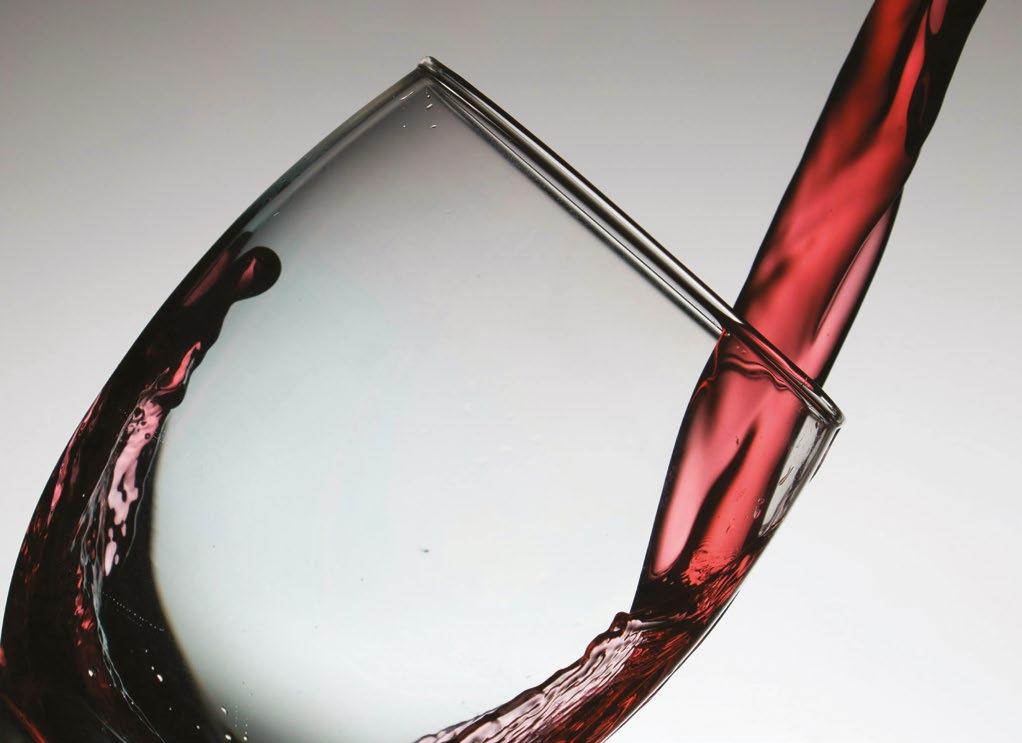
njoying wine is about far more than what’s in the bottle. From the first swirl to the final sip, the right glassware can elevate an ordinary pour into a sensory experience. A well-chosen glass not only flatters the wine but also unveils its full story, its aroma, flavour, intensity, length, and texture.
Wine glasses are designed with purpose. A large, rounded bowl gives red wines the space they need to breathe, open up and releasing complex aromas. White wines, by contrast, often shine in narrower bowls that preserve freshness and direct delicate scents towards the nose. Sparkling wines benefit from tall, slender flutes or tulip shapes that maintain effervescence, while dessert wines are usually served in smaller glasses that focus sweetness and aroma. Simply put: the glass is not just a vessel, it’s a tool.
Few names have shaped this understanding as much as Riedel, the house that introduced varietal-specific glasses. Their work showed how the curve of the bowl, the width of the rim, and even the thickness of the crystal could alter how wine tastes. Alongside Riedel, boutique producers such as Zalto have set benchmarks for elegance with their feather-light, hand-blown creations, widely regarded as some of the most refined glasses in the world.

“THE GLASS IS NOT JUST A VESSEL — IT’S A TOOL. THE RIGHT STEM CAN ELEVATE EVEN A MODEST BOTTLE, TRANSFORMING A SIMPLE POUR INTO A SENSORY EXPERIENCE.”
Of course, not every table calls for a cellar full of fragile, hand-blown stems. For those seeking professional-grade glassware that balances beauty, quality, and practicality, Spiegelau and Nachtmann deliver just that. Both are produced in the same facilities as Riedel, with the same uncompromising standards, yet are designed to be more accessible for everyday use.
Spiegelau has become especially popular thanks to ranges like Definition, known for its fine, lightweight stems, and the new Hi-Lite collection, which marries precision with
remarkable value. Nachtmann, on the other hand, brings artistry into play; their Noblesse and Vivendi collections combine durability with a design-forward look that adds character to the table.
Building a stemware collection doesn’t need to be overwhelming. For most wine lovers, a small but versatile set covers all bases. Start with one generous red wine glass – or, for the enthusiast, two: a wide-bowled Burgundy glass for Pinot Noir and delicate reds, and a taller Bordeaux glass for structured varieties like
Cabernet Sauvignon. Add one good white/ universal glass, versatile enough for everything from Sauvignon Blanc to Chardonnay (although for top white burgundies, you can also use a Pinot Noir glass). For sparkling wines, skip the traditional flute and opt for a tulip-shaped glass that both preserves bubbles and enhances aroma. And don’t forget a sturdy, stylish water tumbler – an essential companion to any wine service. Many leading glassmakers offer bundles that include three or four different styles, making it easy to build a well-rounded collection without overcomplicating things.
Villa’s Culinary Duo: Rosami and OKA’s At The Villa
Located within one of the oldest structures in the Balluta area, an imposing century-old palazzo, Rosami seeks to break down the walls of fine-dining idealism. Rooted in a produce driven philosophy, the restaurant sources its ingredients directly from Xara Gardens, o ering guests a feast for all the senses.


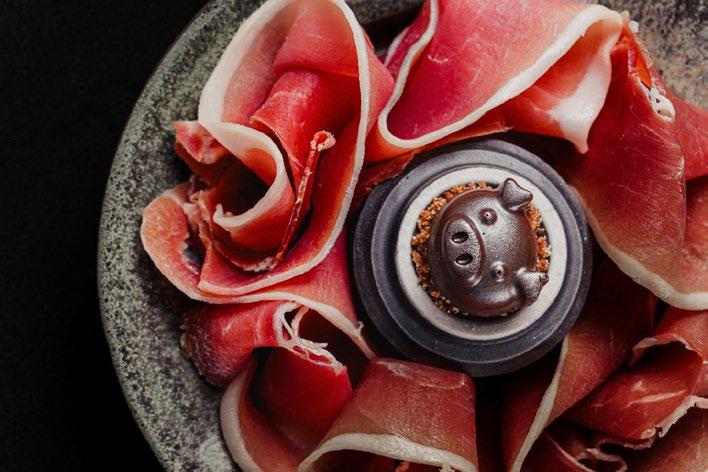
Rosami is especially renowned for being the only restaurant on the island to o er a Carte Blanche tasting menu, an ever-changing culinary journey curated solely from the day’s available ingredients.

This unique approach invites guests to embrace the magic of the unknown and indulge in a true culinary adventure.
“FROM THE FIRST SWIRL TO THE FINAL SIP, THE RIGHT GLASS REVEALS THE WINE’S FULL STORY — ITS AROMA, FLAVOUR, AND SOUL.”


Even the perfect glass will disappoint if not properly cared for. Residual detergent, musty cupboards, or streaks can dull both appearance and aroma. The golden rules: rinse glasses with hot water, avoid strong soaps, and always dry with a lint-free polishing cloth used exclusively for glassware (ask your local supplier of glassware). Hold the bowl and stem separately while polishing to avoid breakage, and store them upright, away from kitchen odours. The reward is a sparkling, neutral canvas for your wine.

Ultimately, glassware is about respect. Respect for the gifts of nature, for the winemaker’s craft, for the occasion, and for yourself. The right stem can elevate even a modest bottle, making everyday moments feel special. Whether it’s a structured red in a broad bowl, a crisp white in a tapered stem, or a celebratory fizz in a flute, the glass completes the experience.
So next time you reach for a bottle, pause before you pour. Choose a glass that lets the wine shine. Because if the wine matters, so should the glass.

"SHAPE DEFINES FLAVOUR AND THE RIGHT GLASS CAN TURN A SIP INTO A STORY."
Zalto Glasses available from Philippe Martinet Fine Wines 239 Tower Road, Sliema www.martinet-finewines.com
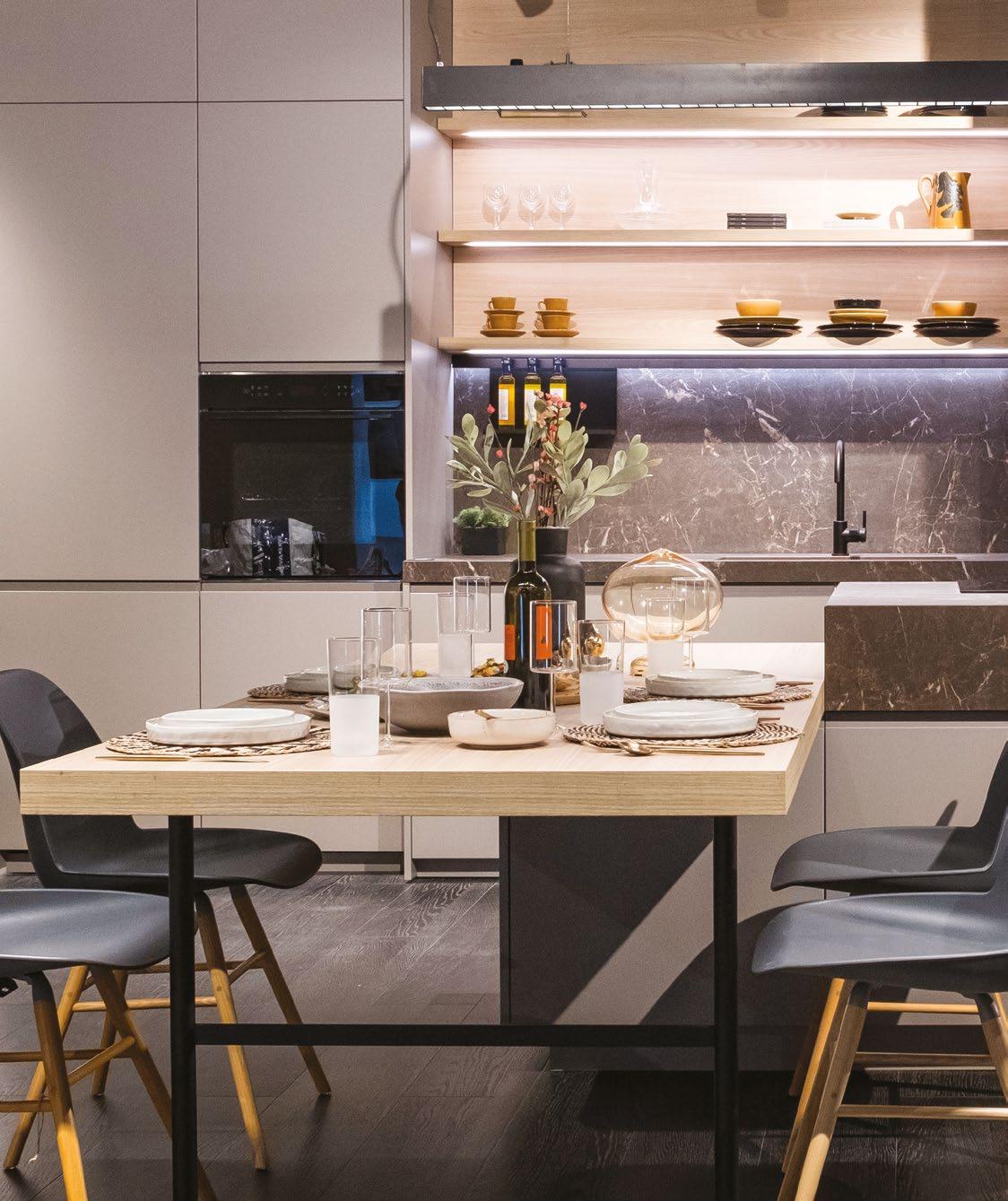
Fresh, Bright, and Full of Life. This spread celebrates the art of balance — dishes that are light yet satisfying, elegant yet effortless. From the zesty freshness of Amberjack Kinilaw with Infused Coconut Milk, Pico de Gallo & Mango, to the crisp, nutty notes of Zucchini Salad with Pecans, Parmesan & Mustard Vinaigrette, and the comforting indulgence of Easy Shrimp Sushi Bakes, each recipe brings a burst of texture, colour, and creativity to the table. Perfect for sharing, savouring, and welcoming the season with style.

Ingredients:
For the Fish
300g (10 oz) sashimi-grade amberjack (or other firm white fish like tuna, snapper, or mahi-mahi), diced into small cubes
¼ cup fresh calamansi juice or lime juice (lemon works if needed)
½ tsp sea salt
For the Infused Coconut Milk
½ cup coconut milk (full fat, ideally fresh or canned with no additives)
1 thumb-sized piece of ginger, thinly sliced
1 small red chili or ½ bird’s eye chili (adjust to taste), sliced
1 clove garlic, crushed
Zest of 1 lime
Salt to taste
For the Pico de Gallo
½ cup ripe tomatoes, finely diced
¼ cup red onion, finely diced
1 tbsp chopped cilantro
1 small green chili or jalapeño, minced (optional)
1 tsp lime or calamansi juice
Salt, to taste
Mango & Garnishes
½ ripe mango, diced into small cubes
Extra cilantro or mint (optional)
Thinly sliced radish or cucumber (optional)
Toasted coconut flakes (optional for crunch)
Method:
Begin by preparing the fish. In a non-metallic bowl, combine the diced amberjack with calamansi or lime juice and sea salt. Stir gently and place in the refrigerator for 10–15 minutes. The acidity will lightly “cook” the fish, as in a traditional kinilaw preparation.
While the fish marinates, infuse the coconut milk. In a small saucepan, gently warm the coconut milk over low heat along with the ginger, sliced chili, garlic, and lime zest. Let it steep for 5–10 minutes without boiling. Strain out the solids, season the infused milk with a pinch of salt, and let it cool completely.
To make the pico de gallo, combine the diced tomatoes, red onion, chopped cilantro, chili (if using), lime juice, and salt in a bowl. Mix well and let sit for 5–10 minutes to allow the flavors to meld.
Once the fish is ready, drain off most of the citrus juice, leaving just a little for brightness. Add the infused coconut milk, the mango cubes, and a few spoonfuls of pico de gallo to the fish. Gently mix everything together and taste — adjust the seasoning, spice, or acidity as needed.
To serve, spoon the kinilaw into a shallow bowl or onto a plate. Garnish with fresh herbs, thinly sliced radish or cucumber, toasted coconut flakes, or a few extra cubes of mango if desired. Serve immediately for the freshest flavor and texture.
By Eunice Muscat – Prep time: 15min – Serves: 4
A REFRESHING, BOLD, AND BEAUTIFULLY LAYERED DISH, THIS FILIPINO-STYLE KINILAW IS MADE WITH SASHIMI-GRADE AMBERJACK MARINATED IN CITRUS, THEN GENTLY DRESSED WITH INFUSED COCONUT MILK, PICO DE GALLO, AND RIPE MANGO. IT’S BRIGHT, CREAMY, SPICY, AND UTTERLY ADDICTIVE — A PERFECT BALANCE OF FLAVOR AND TEXTURE.
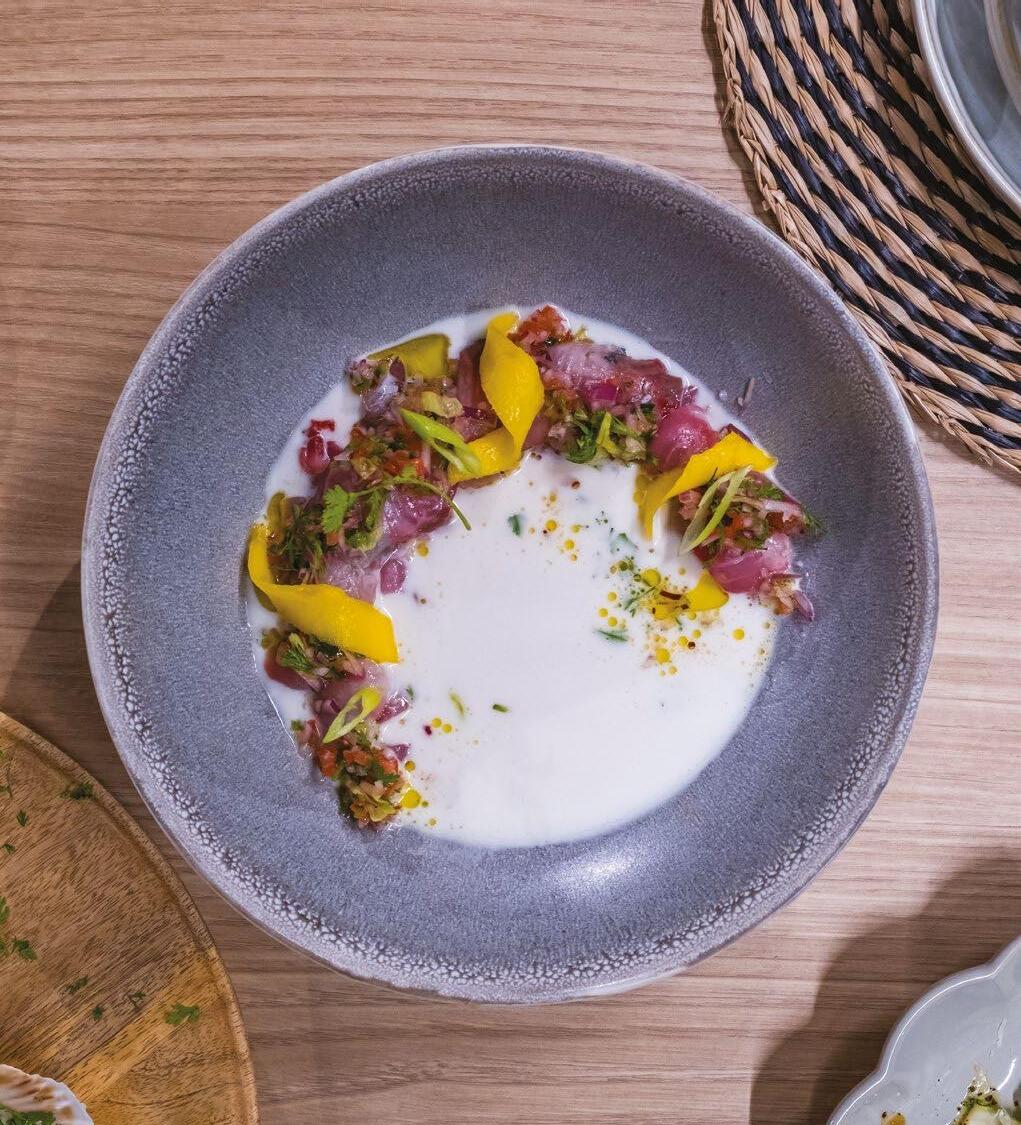

FRESH, VIBRANT, AND FULL OF TEXTURE, THIS ZUCCHINI RIBBON SALAD BRINGS TOGETHER CRISP RIBBONS OF ZUCCHINI, TOASTED PECANS, SALTY OLIVES, AND SHAVINGS OF PARMESAN, ALL TIED TOGETHER WITH A TANGY MUSTARD VINAIGRETTE. IT’S QUICK TO PREPARE AND PERFECT FOR SUMMER DINING.
Ingredients:
For the Salad:
2 medium zucchinis
¼ cup toasted pecans, roughly chopped
¼ cup shaved Parmesan cheese (or more, to taste)
¼ cup black or Kalamata olives, pitted & halved
Fresh basil leaves (optional, for garnish)
For the Mustard Vinaigrette:
2 tsp Dijon mustard
1 tbsp red wine vinegar (or lemon juice)
3 tbsp extra virgin olive oil
1 small garlic clove, finely minced (optional)
Salt & freshly ground black pepper, to taste
½ tsp honey or maple syrup (optional, for balance)
Method:
Start by using a vegetable peeler or mandoline to shave the zucchinis lengthwise into thin ribbons. Place them in a large bowl and lightly sprinkle with salt to help draw out excess moisture. In a small bowl or jar, whisk together the Dijon mustard, red wine vinegar (or lemon juice), minced garlic (if using), and honey or maple syrup. While whisking, slowly drizzle in the olive oil until the vinaigrette emulsifies. Season to taste with salt and freshly ground black pepper.
Toss the zucchini ribbons gently with the vinaigrette until evenly coated. Arrange the salad on a plate and top with the chopped toasted pecans, halved olives, and shaved Parmesan. Garnish with fresh basil if desired.
Serve immediately for the best texture, or refrigerate for 10–15 minutes before serving.
Tip: For extra flavor, toast the pecans in a dry skillet over medium heat for 2–3 minutes. If your zucchini is especially watery, let the ribbons sit in a colander with a bit of salt for a few minutes, then gently pat them dry before adding the dressing.
IF YOU’RE CRAVING SOMETHING A LITTLE MORE PLAYFUL, THESE MINI SHRIMP BAKES DELIVER. RICH WITH CREAMY MAYO, A HINT OF SRIRACHA HEAT, AND A PERFECTLY GOLDEN RICE BASE, THEY STRIKE THAT IRRESISTIBLE BALANCE BETWEEN COMFORT AND SOPHISTICATION. IDEAL FOR SHARING, SNACKING, OR IMPRESSING YOUR NEXT DINNER GUEST.
Ingredients: (Makes ~12 mini bakes)
For the Rice Base
2 cups cooked sushi rice (or short-grain rice)
2 tbsp rice vinegar
1 tbsp sugar
½ tsp salt
For the Shrimp Topping
250–300g (9–10 oz) cooked shrimp, chopped
1 cup mayonnaise (preferably Kewpie)
1 – 2 tbsp sriracha (adjust to taste)
1 tsp soy sauce
1 tsp lemon juice (optional)
1 scallion, chopped (optional)
For Assembly
Nori sheets, cut into small squares (optional, to line or top)
Sesame seeds (optional)
Extra sriracha or spicy mayo (for drizzling)
Cooking spray or oil (for greasing)
Method:
Preheat the oven to 375°F (190°C) and lightly grease a 12-cup standard muffin tin with oil or cooking spray. While the oven heats, season the rice by mixing the warm cooked sushi rice with rice vinegar, sugar, and salt. Stir thoroughly and set aside to cool slightly.
In a separate bowl, prepare the shrimp topping by combining the chopped cooked shrimp with mayonnaise, sriracha, soy sauce, lemon juice, and chopped scallions if using. Mix until evenly coated.
To assemble, press about 2 tablespoons of the seasoned rice firmly into the bottom of each muffin cup. Top with a generous spoonful of the shrimp mixture. If you’d like, you can add a small square of nori beneath the rice or on top of the shrimp for added sushi flavor.
Bake for 12–15 minutes, until the tops are slightly golden and set. For a crispy finish, broil for the last 1–2 minutes — just keep an eye on them so they don’t burn.
Let the sushi bakes cool for a few minutes, then use a spoon to gently lift each one out of the tin. Drizzle with extra sriracha or spicy mayo before serving.
Eunice
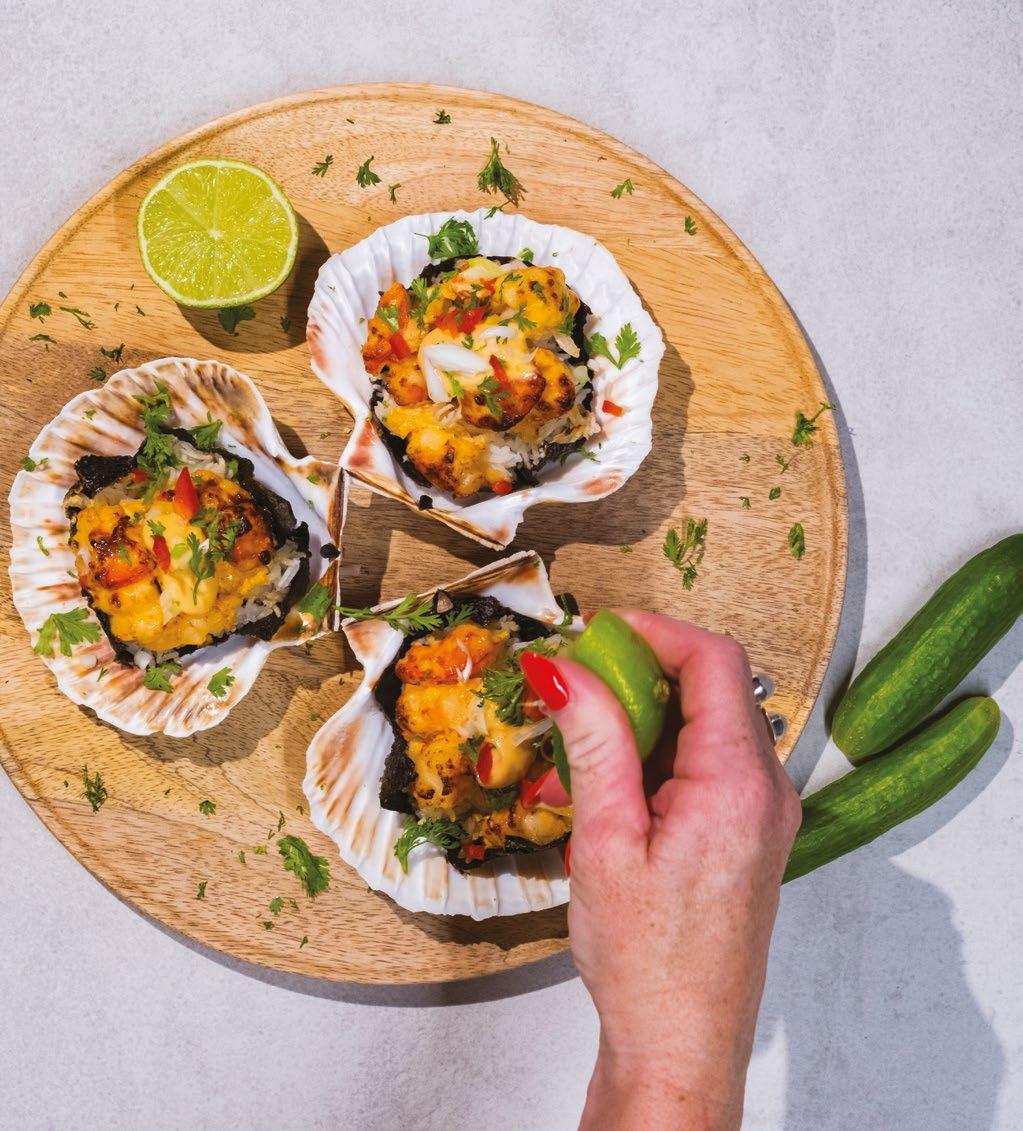


Under a canopy of bamboo and sky, cooking becomes something closer to meditation. The air hums with the scent of lemongrass, the gentle crackle of woks, and the low murmur of voices learning the language of Thai flavour. This is no ordinary classroom. It’s a living sculpture, a sweeping, bull-shaped bamboo pavilion where food, architecture, and culture come together in one flowing movement.
Designed by Chiangmai Life Architects, the structure is equal parts beauty and purpose. Its curved bamboo horns rise like a welcome gesture, guiding visitors through three domed spaces, one for preparing, one for cooking, and one for gathering. Light filters softly through the roof by day; at night, it glows golden, transforming lessons into something almost ceremonial.
Here, the act of cooking is not confined to recipes but rooted in rhythm, community, and connection to the land. It’s a celebration of Thai hospitality, where sustainability meets artistry, and every meal begins with awe.

At Zabb e Lee Cooking School, food is never just about recipes. It is about place, culture, and the beauty of shared experience. Visitors from around the world come to learn the art of Thai cooking, and now they do so under the sweeping curves of one of Thailand’s most striking bamboo pavilions.
The newest teaching sala, designed by Chiangmai Life Architects, is unlike any classroom you have seen. Set at the far end of the school’s leafy property, between a centuries
old tree and a quiet pond, the pavilion takes the dramatic form of a bull’s head. Its arched bamboo horns rise upward to form welcoming entrances, leading into three distinct domes: one for food preparation, one for cooking, and one for gathering at a long dining table.
The design is both practical and poetic. From the front, the pavilion draws the eye instantly, a sculptural landmark that seems alive with energy. Inside, the bamboo arches create soaring dome like interiors that feel far
larger than their footprint. Natural light filters through the roof shingles, while in the evening, carefully placed lighting casts a golden glow on the warm honey coloured bamboo. The atmosphere shifts from lively during the day to magical at night, perfectly suited to the rhythms of Thai cooking classes.
Beyond beauty, the design speaks to values shared by both the cooking school and the architects: connection to nature, respect for tradition, and sustainability. Bamboo, harvested

locally and treated for durability, forms the backbone of the structure. Not only is it strong and versatile, but it also absorbs carbon dioxide during growth, giving the building a negative carbon footprint. In other words, the Bull Pavilion does not just provide a place to cook and eat, it actively contributes to a greener planet.
For students, the experience is immersive. Imagine kneading dough for curry puffs at one of ten prep stations while just across the sala the sizzle of stir fries fills the air at ten cooking
stations. Finally, everyone gathers at the central dining table to share a meal overlooking rice fields, the bamboo arches soaring above like guardians of the feast.
Chiangmai Life Architects, led by Markus Roselieb and Tosapon Sittiwong, are known for their philosophy of Functionality, Sustainability, and Smiles. Each of their projects is designed to serve its purpose well, tread lightly on the earth, and bring joy to those who use it. The Bull Pavilion captures all three, proving that
a cooking school can be more than just a classroom. It can be an experience that stays with you long after the taste of Thai basil and lemongrass has faded.
At Zabb e Lee, food and architecture come together in harmony. The Bull Pavilion is not simply a space for cooking classes. It is a celebration of Thai hospitality, a place where bamboo, community, and cuisine intertwine. >>



Ingredients:
For the Panna Cotta
65g cooking cream
55g white sugar
1ml coffee essence
½ sheet gelatin
60g Greek yogurt
For the Fig Granola
50g oats
2g dried pomegranate
12g dried fig, diced
7g crushed pistachio
1 pinch cardamom powder
30ml honey
1 pinch sea salt
10g black raisin
2g mixed sesame seeds
5g pumpkin seeds
7g sunflower seeds
"SILKY
For the Cranberry Caviar
100ml cranberry juice
2g agar-agar powder
1g salt
1 pinch dry mint powder
5g sugar
For the Cranberry Glaze Sauce
60ml cranberry juice
5g white sugar
1 pinch sea salt
For Assembly
1 pc panna cotta
60g fig granola
1/8 tsp cranberry caviar
10ml cranberry glaze sauce
1 strawberry
2 blueberries
Method:
Panna Cotta
Soak the gelatin sheet in water for 10 minutes. Gently warm the cooking cream with the sugar, then dissolve in the gelatin. Stir in the coffee essence and Greek yogurt until fully combined. Pour into a mold and chill for 2 hours.
Fig Granola
Mix all ingredients in a bowl. Spread on a tray and roast in a preheated oven at 170°C for 15 minutes.
Cranberry Caviar
In a saucepan, heat all ingredients except the agar-agar and bring to a boil for 5 minutes. Add the agar-agar and boil for another 2 minutes. Strain and transfer to a squeeze bottle. Cool the liquid to at least 30°C.
Drop the liquid slowly into 500 ml chilled corn oil, forming caviar pearls. Strain the oil and rinse the caviar in cold water.
Cranberry Glaze Sauce
Combine all ingredients in a saucepan and cook over medium heat for 5 minutes
Assembly
Place the panna cotta at the center of a plate. Add fig granola beside it. Garnish with cranberry caviar, a drizzle of cranberry glaze sauce, and fresh berries.
Ingredients:
For the Mango Delight Sauce
60ml mango purée
2ml lemon juice
10g sugar
1 pinch sea salt
For the Creamy Cheese Roll
50g cream cheese
10ml heavy cream
5ml honey
1 pinch lime zest
5g chopped raisins
3g chopped pistachio
For the Maple Coral Chips
1 egg white
20g all-purpose flour
10g butter
10 g white sugar
For the Cranberry Caviar
100ml cranberry juice
½ tsp agar-agar powder
¼ tsp salt
1 pinch dry mint powder
1 tsp sugar
For the Chia Seed Mix
10g chia seeds
50ml water
For Assembly
60ml mango delight sauce
3 pcs creamy cheese roll
1 pc maple coral chip
20g cranberry caviar
10g chia seed mix
1 mint leaf
Method:
Mango Delight Sauce
Combine all ingredients in a saucepan and cook for 10–20 minutes until smooth and thickened. Let cool, then refrigerate.
Creamy Cheese Roll
Mix all ingredients together. Shape into rounds using a mold and chill for 30–40 minutes.
Maple Coral Chips
Combine all ingredients and mix well. Spread the mixture on a maple design silicone sheet and bake at 160°C for 8–9 minutes.
Cranberry Caviar
In a saucepan, heat all ingredients except the agar-agar and boil for 5 minutes. Add agar-agar and boil for 2 more minutes. Strain and transfer to a squeeze bottle. Cool to at least 30°C.
Drop into 500 ml chilled corn oil drop by drop to form caviar. Strain the oil and rinse the caviar in cold water.
Chia Seed Mix
Soak the chia seeds in water for 30 minutes.
Assembly
In a glass, spread the mango delight sauce as a base. Place the maple coral chip on top. Arrange the creamy cheese rolls to the side with the cranberry caviar and chia seed mix. Finish with a mint leaf on top.

By Eunice Muscat – Prep Time: 15min
– Serves 4–6
Ingredients: SIMPLE, ELEGANT, AND BURSTING WITH NATURAL SWEETNESS, THESE RICOTTA-STUFFED FIGS ARE THE PERFECT BITE-SIZED TREAT. CREAMY RICOTTA MEETS BRIGHT CITRUS, CRUNCHY PECANS, AND A DRIZZLE OF MAPLE SYRUP — IDEAL AS A REFINED STARTER OR A LIGHT, NO-FUSS DESSERT.
8–10 fresh ripe figs
½ cup ricotta cheese
Zest of 1 orange
1–2 tsp fresh orange juice
¼ cup toasted pecans, (finely chopped)
2–3 tsp maple syrup (plus extra for drizzling)
Pinch of cinnamon or nutmeg (optional)
Fresh mint leaves (optional, for garnish)
Sea salt flakes (optional, for finishing)
Method:
Start by preparing the ricotta filling. In a small bowl, mix the ricotta with orange zest, orange juice, maple syrup, and a pinch of cinnamon or nutmeg if using. Stir until the mixture is smooth and creamy, then taste and adjust sweetness as desired. Next, gently wash and dry the figs. Using a small knife, cut an “X” at the top of each fig, slicing about halfway down without cutting all the way through. Carefully squeeze the base of each fig to slightly open the top, creating a small pocket.
Spoon about 1–2 teaspoons of the ricotta mixture into each fig. Once filled, sprinkle over the finely chopped toasted pecans, then drizzle lightly with extra maple syrup. Finish with a few fresh mint leaves and a touch of sea salt flakes, if you like. Serve immediately as a refreshing starter or a beautifully simple dessert.



